Music is the universal language
“Glory to God in the highest heaven, and on earth peace to those on whom his favor rests.” - Luke 2:14
Premier Guitar
A Low-Cost Gamma for the Gigging Guitarist
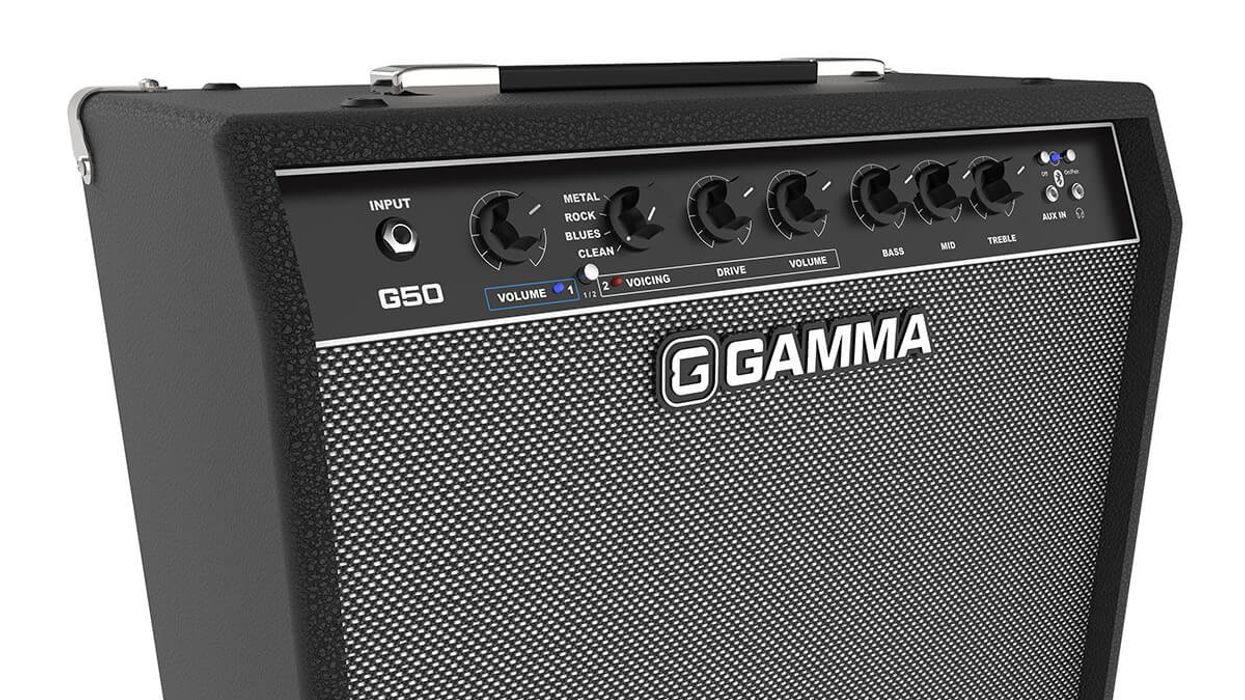
Before getting to the Gamma G50 ($199 street) amp that has solved a lot of problems in my professional life, I should explain my musical day-to-day. One month, I clocked gigs in Jewish old people’s homes for Holocaust survivors, followed by an outdoor concert backing Bootsy Collins. Then, three bluegrass gigs and five gigs with a horn section soul band. Most of those were powered by a mid ’80s Polytone Mini-Brute with a Muzizy 5-band EQ and a cheap reverb pedal. The Mini-Brute is the Dodge Dart of guitar amps—compact and unkillable. I loved that amp as I would a favorite uncle. And like my favorite uncle, it died, to nobody’s surprise, shortly after my 53rd birthday.
I’ve tried different micro-amps. Since my electric life is low volume (mostly jazz or Latin music, with occasional klezmer thrown in), 50 watts is fine by me. If you live roadie-free as I always have (my painfully brief stint with NRBQ notwithstanding), the braggadocio about tone gives way to “fits in the car,” “isn’t hard to lift,” and—this is huge—“doesn’t break.”
There are two schools of thought about amps: The first is that the amp completes the sound of your guitar, which is a Marshall aesthetic. The second is that your amp should sound like whatever you plug into it, maybe with a little reverb for dimension, and that’s Fender thinking. I am definitely a Fender thinker.
My effects rack is minimal—reverb, tremolo, and analog delay (for rockabilly slapback). And the Muzizy EQ.
In my formative years, the amps around my neighborhood were battered Supros, Silvertones, and Univoxes. The guitars were mostly Penco, Morris, Hondo II, Harmony, Silvertone, and unbranded Strat copies. It was how you made do until you could afford something decent.
But inexpensive guitars improved. First lawsuit guitars, then Squier, whose Japan-built Telecasters surpassed their American-made counterparts. Now Harley-Benton et. al. have revolutionized the market.
As a man old enough to recall the Dodge Dart, I look back with longing to the barebones interface of a Supro solid-state combo amp. Who makes that nowadays?
Acoustic has been reborn as Acoustic Control Corporation. Their signature combo amp is the Gamma, available in either a 25- or 50-watt version. The 50 weighs 25 pounds, runs two channels, features a 4-position “voicing” selector that gives you your choice of metal, rock, blues, and clean. The 12" True Blue speaker sounds close to a Celestion, so that’s not bad. The tone knobs are clean and sensitive, with neither dead spots nor sudden gains. The inherent sonic personality of this amp resembles an Ampeg Reverb Rocket (the 1x12 version), and it weighs less. Kind of miraculous for something with no tubes. Warm, quiet, and non-sterile. The control set? Voicing, volume dials for each channel, 3-band EQ, and drive.
“If you live roadie-free as I always have (my painfully brief stint with NRBQ notwithstanding), the braggadocio about tone gives way to ‘fits in the car,’ ‘isn’t hard to lift,’ and—this is huge—‘doesn’t break.’”
Out on the gig? The first night, I used it with Los Chicos del Mambo, a loud 20-piece band. The job was at the Paramount, a giant wooden room in Los Angeles, whose skilled soundman miraculously kept screaming trumpets from deafening the entire 90033 zip code. The bassist played out of a Laney 200H. I played my Harley-Benton CG-200CE electric classical through the Gamma 50, sans effects. And it cut. Headroom to burn.
The next day, same amp but different venue, band, and guitar. Band—Voodoo 5, the eight-piece exotica group I lead with my wife, vocalist Lena Marie Cardinale. The other instruments are flute, vibraphone, pedal-steel guitar, upright bass, and two Latin percussionists. Venue—the Redwood Bar, whose stage is a squeeze for eight. Guitar—an Indio DLX Plus, which is a Jazzmaster copy but with (huzzah!) a maple fretboard, plugged into my anemic effects rack.
The room is smaller, but with a long trajectory from the bandstand to the back. For this performance, I didn’t modify my guitar tone other than to hit the pickup switch. The Muzizy was set to its usual place, reverb on for the whole show, and I only hit the tremolo box on two songs. Guitar and amp doing basic duty.
From Instagram videos, I heard what the audience heard through my $10 earbuds, giving me an un-glamourous idea of what went out into the room, and I am mightily impressed by how formidable the G50 is. Even in the battlefield recording conditions, the presence, reach, warmth, and clarity were unmistakable.
Maybe I was going in search of the simpler operating procedures of my early musical life, but I really wanted an amp that boasts fewer knobs and delivers the character of whatever I plug into it. That it comes in at a price we can all afford and a weight we can all lift is gratifying to this old—old—pro.
Foot-Controlled Analog Delay?? | Black Mountain Roto Echo
PG contributor Tom Butwin walks us through a rugged, pedal‑board‑friendly delay that lets you shape time, feedback, and blend entirely with your foot. The Roto Echo features warm, gritty analog‑style echoes, intuitive real‑time control, and a design tough enough for full body weight. It sounds great on its own, but this wheel‐driven innovation opens up worlds of expressive possibilities.
Black Mountain Roto-Echo
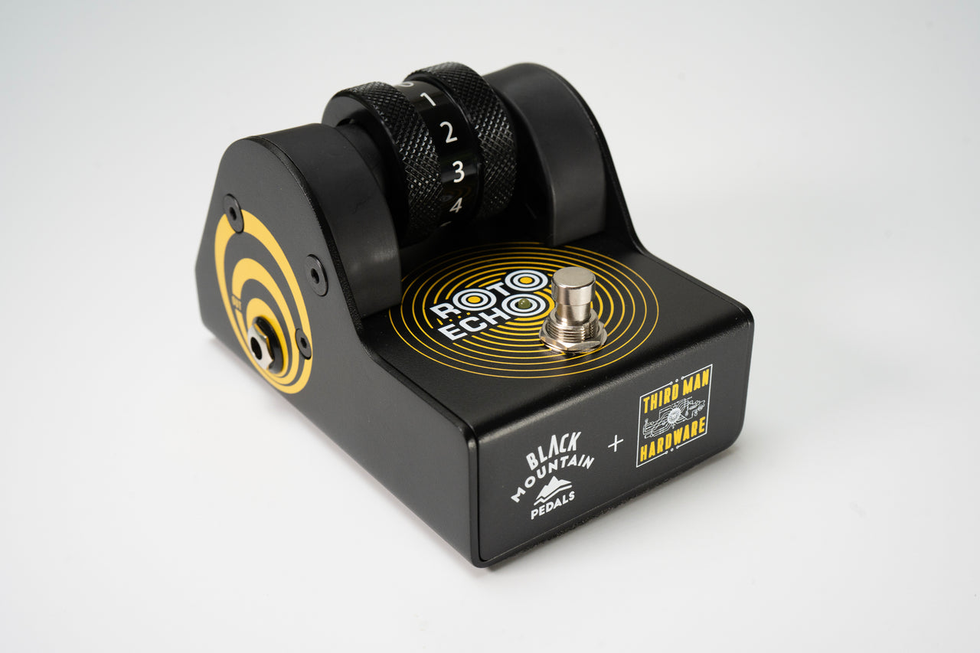
Third Man Hardware and Black Mountain are excited to announce the innovative Roto-Echo delay pedal. Instead of tweaking delay parameters with your fingers, the pedal’s
Freewheel® Technology allows players to change them with their feet in real-time as they play –
a small change that leads to tons of creative possibilities.
The Roto-Echo is built tough and players can put their full weight onto the pedal with no
problem. It’s the same size as a regular Boss-style guitar pedal, and fits on any pedal board.
Key Features
● Foot-Controlled Adjustments: Change Time, Feedback, or Blend while you play.
● Analog-Style Delay: Warm, gritty echoes up to 600ms.
● Rugged Build: Built to handle full body weight on stage.
● True Bypass: Keeps your tone pure when switched off.
● Play Sitting or Standing: Built for performance.
● 9V, Center Negative Power
● Morph feedback from short to infinite repeats
● Ramp wet/dry mix for dramatic effect
● Sweep delay time to bend and warble pitch, and so much more
Voltage Cable Co.® Releases “Tele” Plug for the Voltage Vintage Coil® V2
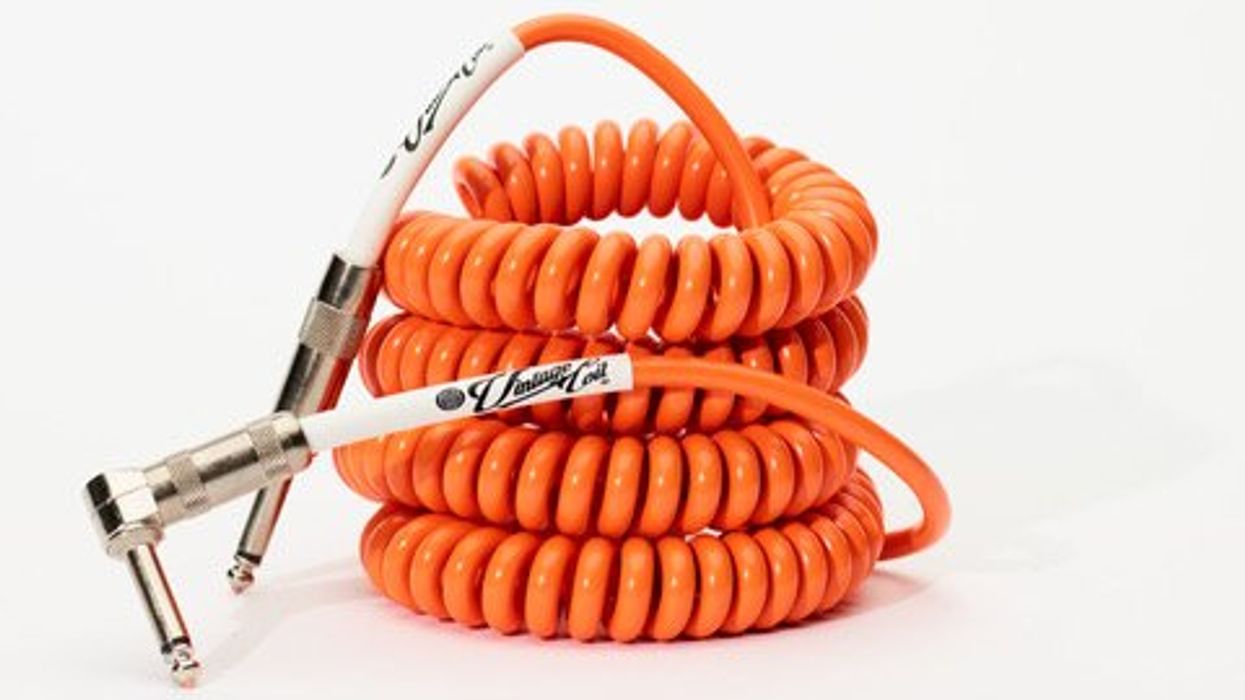
Voltage Cable Co.® has introduced a new hardware option to its best-selling Voltage Vintage Coil® V2: a long-frame right-angle “Tele” plug by G&H USA. Purpose-built for recessed Tele guitar jacks and vintage-style guitars, this new plug ensures a tighter fit and improved seating depth - solving a long-standing problem for players using standard short right-angle connectors.
Each cable continues to feature Voltage’s hallmark component stack: 21 AWG spiral-shielded conductors, Cardas Quad Eutectic silver solder, and the patented ISO-COAT® hermetic seal, now officially granted under Australian Standard Patent No. 2024204464 as of June 26, 2025. The result is an elite-class instrument cable with lifetime-grade durability and signal reliability, built specifically for working musicians.
The Voltage Vintage Coil® V2 is available in seven vintage-inspired colors and ships globally.
Available now at $99 USD MAP: voltagecableco.com/products/coiled-guitar-cable-voltage-vintage-coil-v2
Tony Iommi Signature Humbucker
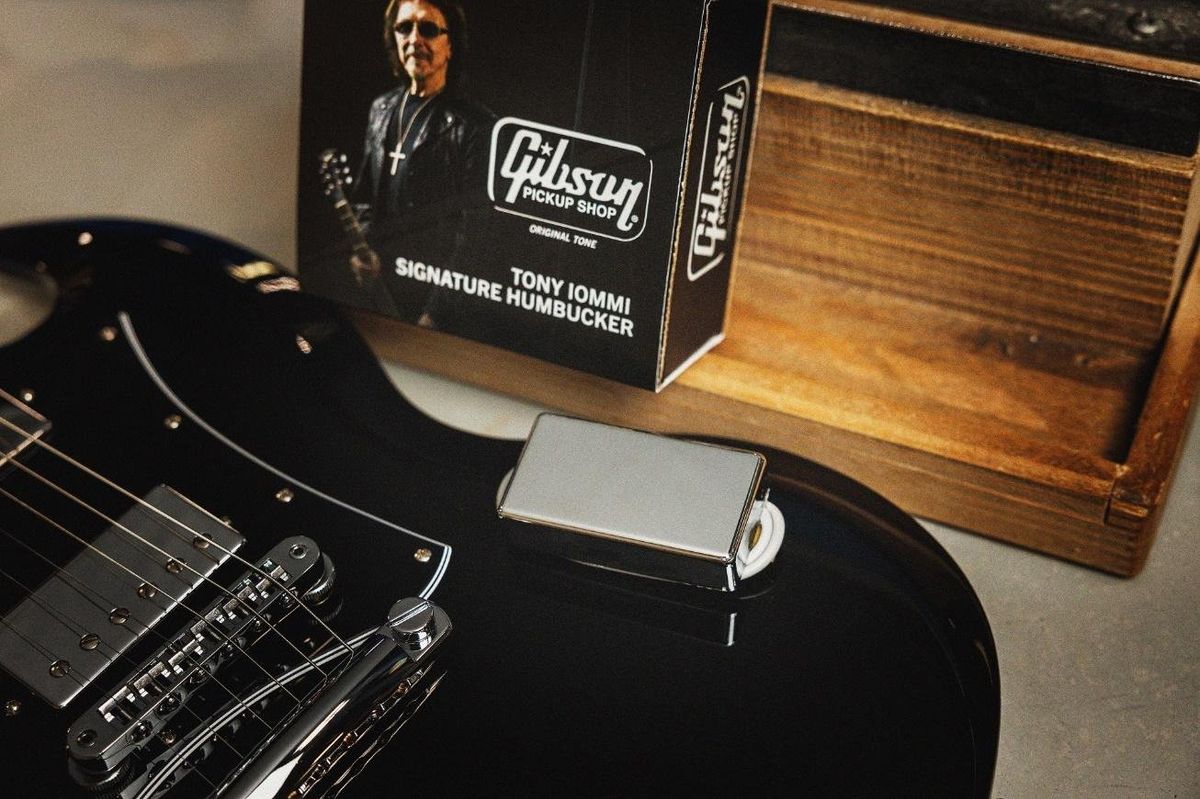
The Gibson Pickup Shop Artist Collection pickups are created in collaboration with some of the world’s most influential artists, including legends who shaped the sounds that built the foundation of modern music, as well as some of today’s most innovative players who continue to shape the sound of music across genres and influence musicians worldwide. Gibson is proud to continue its partnership with Tony Iommi, the legendary guitarist of Black Sabbath, with the launch of the Tony Iommi Signature Humbucker™, available worldwide on www.gibson.com.
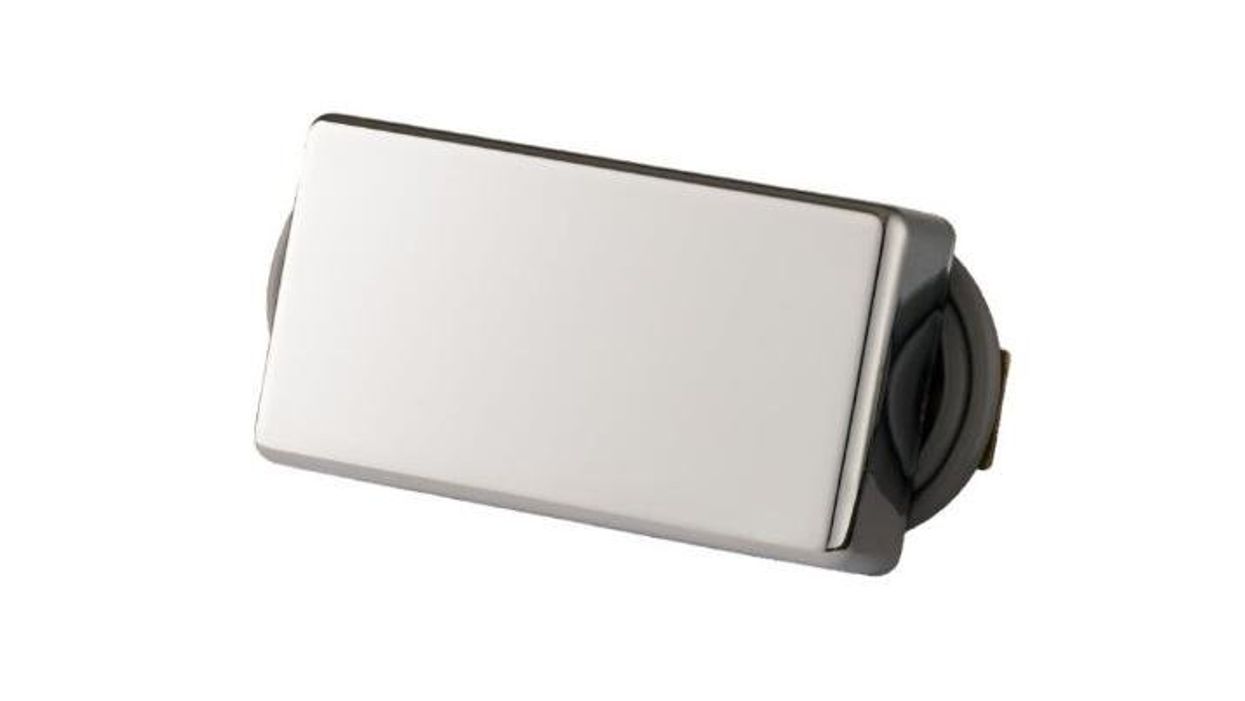
Tony Iommi’s legendary guitar work, powerful sound, and groundbreaking albums laid the foundation for heavy metal and inspired countless other genres. His music and his legacy are celebrated across the globe, and in the late 90s, Gibson teamed up with Tony to create their very first signature pickup. Today, that original Gibson signature humbucker makes its long-awaited return.
The Tony Iommi Humbucker features an exclusive configuration of powerful ceramic and Alnico 2 magnets, along with unique windings, that give it the incredible tone and sustain that have helped make Tony’s work with Black Sabbath instantly recognizable. Thunderous tone and incredible sustain, with crystal clarity, even in full distortion, the Tony Iommi Humbucker is fully wax-potted and epoxied for absolute protection against unwanted feedback. The 4-conductor wiring allows for series, parallel, and split coil operation.
“I’m really excited that Gibson’s bringing back my signature humbucker, they were getting pretty hard to find!” says Tony Iommi. “This pickup came about after a lot of time spent in Nashville, just experimenting with different setups to get that perfect tone and sustain from my favourite guitars. We had to make sure it worked with my light gauge strings and low tunings, but still pack a punch, and the result has got some serious output. They're on my signature guitars too, and I couldn’t be more pleased with how they turned out."
“I’d personally installed these on one of my Gibson guitars 15 years ago, and I was blown away with the distinct Tony Iommi and Black Sabbath sound I was able to get out of them,” explains Cesar Gueikian, President and CEO of Gibson. “They have such a great, clean look with the unique pickup cover, and we are excited to bring the Rifflord’s signature humbucker back as we continue to pay tribute to Tony.”
“It’s great to have the first signature pickup from Gibson back, and there really isn’t a more fitting artist than Tony Iommi,” says Lee Bartram, Head of Commercial and Marketing EMEA at Gibson. “Tony is synonymous with the Gibson SG™, but now the volume, presence, and overall power he produces through his playing can be experienced in other models too, whether at home, in the studio, or on stage. Thanks to Tony for his continued support and trust; these pickups are the result of our constant collaboration, and we look forward to what’s next for our partnership.”
Third Man Hardware and Black Mountain Designs Introduce the Roto-Echo Delay
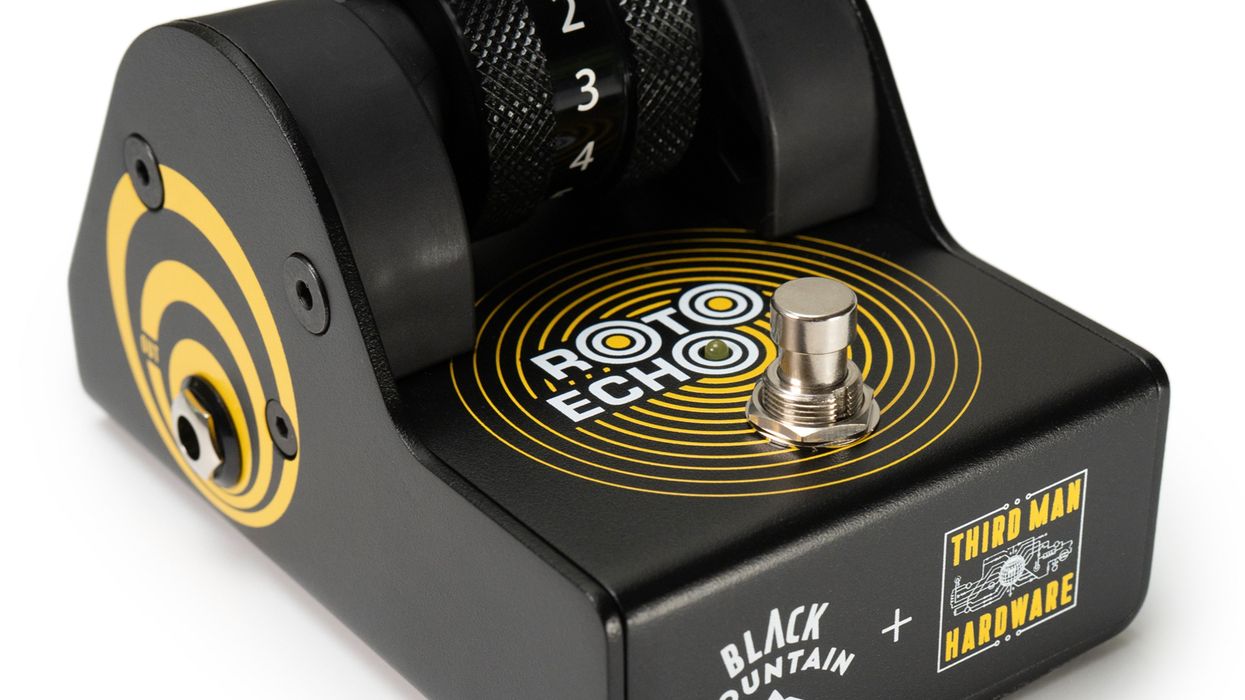
Jack White’s Third Man Hardware and Black Mountain Designs have teamed up to release the Roto-Echo, a new delay pedal designed to give guitarists hands-free control over their delay parameters, in real time, while they perform.
At first glance, the Roto-Echo looks like a familiar-sized delay stompbox. It’s a foot-controlled delay pedal built for the stage and easily fits on a standard pedalboard. On top of the pedal, there’s a roller wheel—smooth, weighted, and spring-loaded. The player can assign that wheel to control blend, feedback, and delay time via a three-way toggle switch. The core delay circuit is based on the PT2399 chip, offering warm, gritty echoes from 60MS a slapback to roughly 588MS repeats.
What makes the Roto-Echo different is how those parameters can be shaped in the moment. The roller wheel responds to foot motion, and with practice, players can perform swells, shifts, or rhythmic changes in their delay sound as they play—no need to crouch down or dial knobs mid-song or rely on presets. Sound manipulation typically reserved for the studio is now easy to perform live.
Specs at a glance:
• Delay Time: 30ms to ~600ms (PT2399-based)
• Roller Wheel: Assignable to Time, Feedback, or Blend. Rated for full body weight.
• Power: 9V DC (center negative)
• Current Draw: <100mA
• True Bypass
• Compact design, pedalboard friendly
The new Roto-Echo pedal carries a street price of $279. For more information visit blackmountainpicks.com.
Share Your Opinion on Amp Modeling Pedals for a Chance to Win

We'd love to hear your thoughts on amp modeling pedals. Answer our short survey and you'll be automatically entered for your chance to win! Don't worry, it will only take a couple of minutes.
Click here to share your opinion and be entered!
The Prize: Fender Vintera II '60s Telecaster Electric Guitar - Sonic Blue
Revive the timeless sound of the '60s with the Vintera® II '60s Telecaster® and experience the iconic looks, inspiring feel and incomparable tone that only a Fender can deliver.
The Vintera® II '60s Telecaster® features an alder body and a maple neck with rosewood fingerboard for classic Fender tone that's full of punch and clarity. The early-'60s "C" shape neck is based on a classic '60s profile for an intuitive and inviting feel, while the 7.25" radius fingerboard with vintage-tall frets provides vintage comfort with ample room for big bends and expressive vibrato. Under the hood, you'll find a pair of vintage-style '60s pickups that deliver all the crystal-clear chime and raw, steely twang that made Fender famous. The vintage-style 3-saddle bridge with slotted steel saddles offers authentic '60s twang, while vintage-style tuning machines provide classic looks with a finer gear ratio and enhanced tuning stability to complete the package.
Experience the unmistakable vintage feel and unmatched sound of a classic Fender with the Vintera® II '60s Telecaster® today and start making music history!
Do These New Fender Guitars Beat Your Vintage Favorite?
Vintage spirit and looks live in a Telecaster and Stratocaster with contemporary refinements at every turn.
Fender American Ultra Luxe Vintage 50s Telecaster
Representing the pinnacle of innovation and craftsmanship, Fender American Ultra Luxe sets the benchmark for premium electric instruments. The new American Ultra Luxe Vintage series takes it a step further, showcasing the finest of Fender heritage – where timeless classics meet uncompromising modern refinement. The American Ultra Luxe Vintage 50s Telecaster features premium ash with carved contours that complement the aged Heirloom™ lacquer finish. Built for precision performance, the quartersawn maple neck with a Modern ‘D’ shape and Ultra rolled edges features medium jumbo stainless- steel frets, Luminlay side dots, and a Graph Tech TUSQ nut. Each instrument features a tapered neck heel to ensure unparalleled access to the higher register. Under the hood, Pure Vintage ’51 Tele pickups deliver classic Fender tones, from sparkling cleans to rich, expressive leads. Performance hardware includes a precision-engineered 6-saddle string-though-body bridge with brass block saddles and deluxe locking short post tuners for quick string changes and superior tuning stability. The American Ultra Luxe Vintage 50s Telecaster delivers flawless modern performance with distinctive classic design. Available in Butterscotch Blonde and White Blonde.
Fender American Ultra Luxe Vintage 60s Stratocaster
Representing the pinnacle of innovation and craftsmanship, Fender American Ultra Luxe sets the benchmark for premium electric instruments. The new American Ultra Luxe Vintage series takes it a step further, showcasing the finest of Fender heritage – where timeless classics meet uncompromising modern refinement. The American Ultra Luxe Vintage 60s Stratocaster features premium alder with carved contours that complement the aged Heirloom lacquer finish. Built for precision performance, the quartersawn maple neck with a Modern ‘D’ shape and Ultra rolled edges features medium jumbo stainless- steel frets, Luminlay side dots, and a Graph Tech TUSQ nut. Each instrument features a tapered neck heel to ensure unparalleled access to the higher register. Under the hood, Pure Vintage ’61 Strat delivers classic Fender tones, from sparkling cleans to rich, expressive leads. Performance hardware includes a precision-engineered 2-Point American Ultra synchronized tremolo with polished stainless steel block saddles, cold rolled steel block, and deluxe locking tuners for quick string changes and superior tuning stability. The American Ultra Lux Vintage 60s Stratocaster delivers flawless modern performance with distinctive classic design. Available in Ice Blue Metallic and Surf Green.
Cheap Trick Announce New Album, All Washed Up, Out Via BMG November 14
The one and only Cheap Trick have announced today’s premiere of their new single. The infectious and anthemic “Twelve Gates” is available now at all DSPs and streaming services. The song heralds the Rock n' Roll Hall of Famers' eagerly anticipated 21st studio album, All Washed Up, arriving via BMG on Friday, November 14 digitally as well as on standard black vinyl and CD. A limited-edition exclusive "Orange Marble" LP variant of the album, limited to 1,000 units, will be available to pre-order via the band's new D2C store.
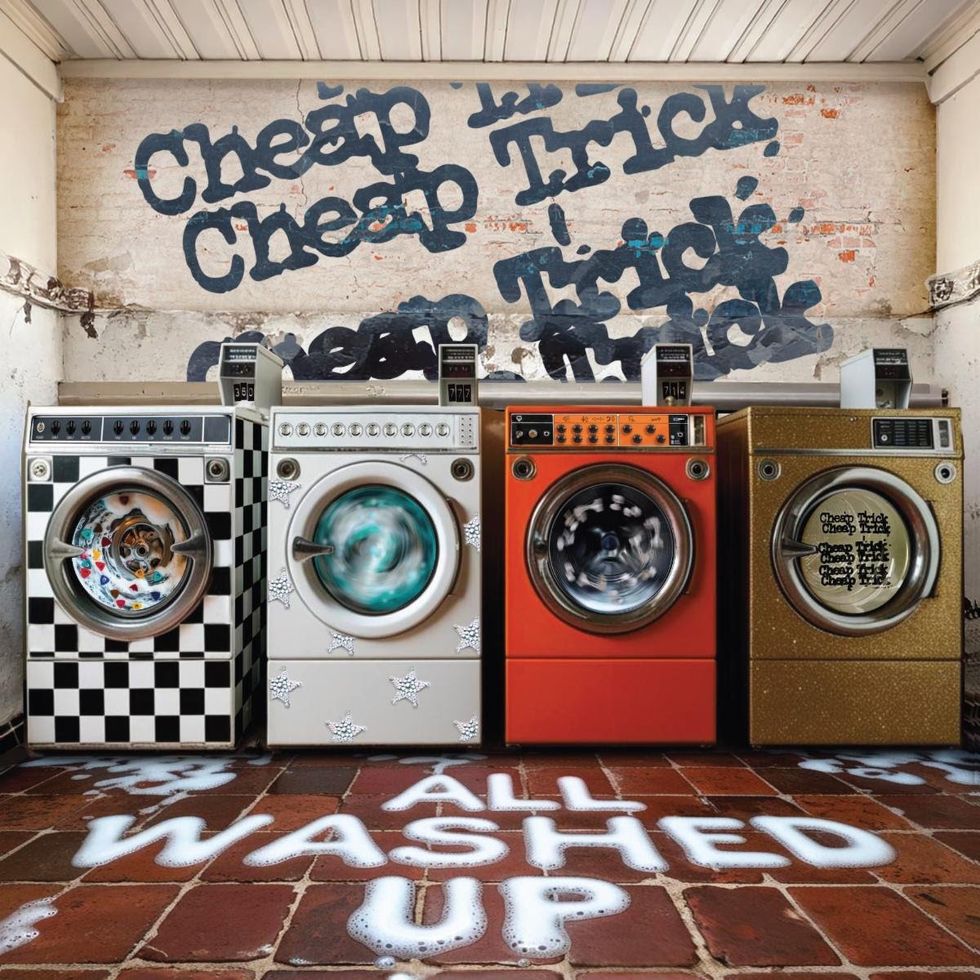
“Our newest single release, 'Twelve Gates,' from the 2025 LP All Washed Up, is one of our best yet,” says bassist Tom Petersson. “ I really love how this song came out. It's one of my favorites on the album.”
All Washed Up was produced by the band and Julian Raymond. It was mixed by Chris Lord Alge and recorded at various studios in Nashville (Sound Emporium Studios, Blackbird, Love Shack, Zen) as well as in LA (Sweetzerland Studios) through 2024.
"Just one more great album from the best rock band in the world," says lead singer/guitarist Robin Zander.Tracklisting:
Cheap Trick have also announced Fall 2025 tour dates to add to their gloriously never-ending run. The new dates start October 12 at Oxford, AL’s Oxford Performing Center and conclude at Vibrant Music Hall in Waukee, IA on December 7. Tickets are on sale now. The complete itinerary is below.
CHEAP TRICK – TOUR 2025
AUGUST
20 – Rhinebeck, NY – Dutchess County Fair
21 – Syracuse, NY – New York State Fair
28 – Salem, OR – Oregon State Fair – LB Day Amphitheatre
31 – Pueblo, CO – Colorado State Fair
SEPTEMBER
19 – Menlo Park, CA – The Guild Theatre
20 – Napa, CA – Blue Note Napa Summer Sessions at Meritage Resort
29 – Osaka, JP – Grand Cube
OCTOBER
1 – Tokyo, JP – Budokan
11 – Miramar Beach, FL – Seascape Resort Golf Club & Tennis Resort
12 – Oxford, AL – Oxford Performing Arts Center *
21 – Huntington, NY – The Paramount *
22 – Bethlehem, PA – Wind Creek Bethlehem – Wind Creek Event Center *
24 – Atlantic City, NJ – Hard Rock Live*
25 – Lynn, MA – Lynn Memorial Auditorium *
NOVEMBER
9 – Chandler, AZ – Wild Horse Pass Hotel & Casino – The Showroom *
11 – Monterey, CA – Golden State Theatre *
14 – Reno, NV – Grand Sierra Resort and Casino *
16 – Turlock, CA – Turlock Community Theatre *
18 – Anaheim, CA – HONDA Center +
23 – Seattle, WA – Climate Pledge Arena +
DECEMBER
2 – Omaha, NE – Baxter Arena +
4 – Green Bay, WI – Reach Center +
5 – Madison, WI – The Sylvee *
7 – Waukee, IA – Vibrant Music Hall *
* Newly Announced Date
+ with Heart
Fish Circuits Echo Limiteur Review
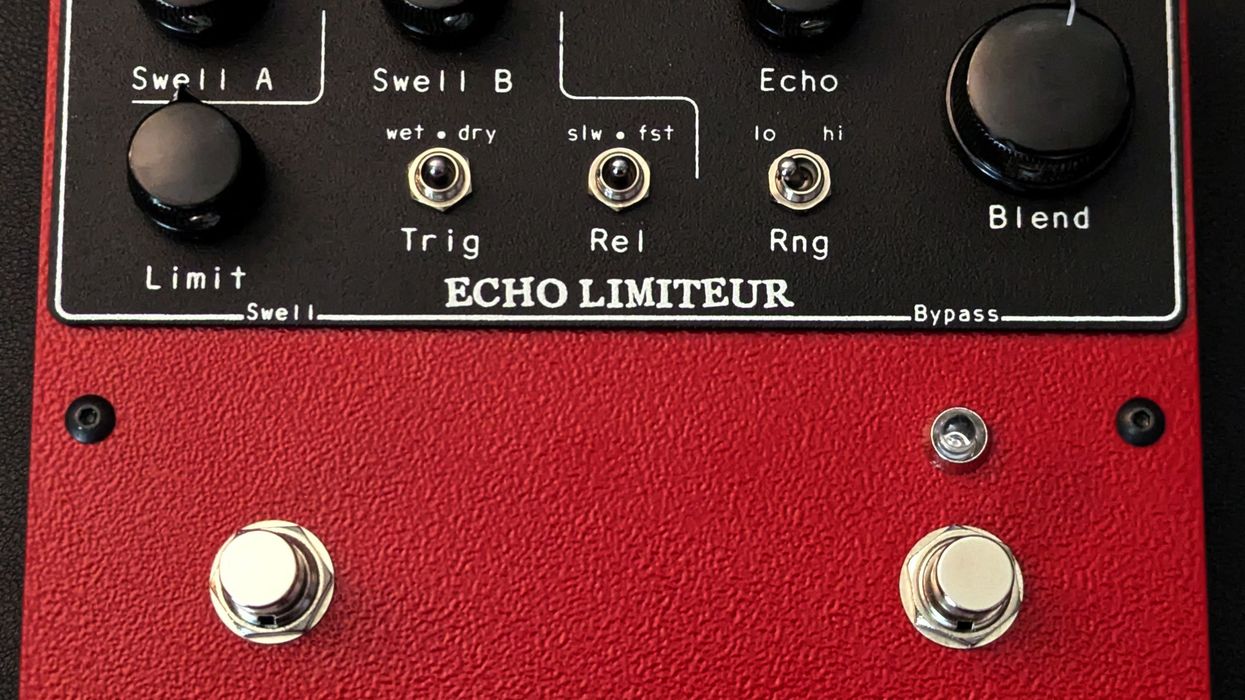
Montreal’s Fish Circuits, helmed by builder Mike Poisson, has made quite a splash the past few years with colorful offerings like the Model One, Lunatique, and most recently the Astronomie, a dynamic reverb that can swell in and out depending on settings and playing style. Fish Circuits’ first delay, the Echo Limiteur, comes in a characteristically sleek box that, like all their others, could be used as a bludgeon. But with an analog delay, a second digital delay, and a limiter, its utility as a tool for defense pales in comparison to the sounds its circuitry produces.
Swell Set Of Features
The Echo Limiteur consists of two delay modes, swell A and swell B. Swell A is a straightforward delay channel, governed just by the global echo and blend knobs and the range switch. The last of these shortens or lengthens the delay-time range of the echo control. “Hi” gives you longer delay times (up to 1150 milliseconds) and slightly cleaner repeats courtesy of the digital PT2399 chip, while “Lo” gives you lower-fidelity repeats and a shorter sweep of possible delay times (up to 650 milliseconds). Both swell A and swell B knobs control the number of repeats.
The limiter affects the swell B mode alone. It limits the delay feedback and can be triggered dynamically by the dry signal, wet signal, or both. This effectively means you can use infinite repeats that won’t overpower your dry sound and/or infinite repeats that reset each time you pick a note or chord. The release switch tells the limiter how quickly to lay off the limiting, while the trigger lets you decide whether a dry, wet, or combined signal activates the limiter. Limit, meanwhile, controls the sensitivity of the trigger: All the way counter-clockwise, it’s nearly non-existent, while fully clockwise, the slightest noise in your signal will trigger the limiter, chopping the repeats. All three controls are extremely interdependent.
Got it? Probably not. You have to physically experience the responses of each of these features to really grasp how they manipulate the signal. And there will be some who wish the Echo Limiteur’s switch-controlled functions were more deeply tweakable. Not me though; we are in the age of the pedal-builder-as-auteur, and I loved allowing my playing to be guided by Poisson’s preset parameters.
Push it to the Limit
Playing through the dynamic-delay side of the Echo Limiteur immediately expands the possibilities of your instrument. Because it responds to playing dynamics, it’s not exaggerating to say there are endless ways to apply the Echo Limiteur. You can set it for a cavalcade of tight, spiraling repeats that cut out sharply the second you play another note, or you can tone down the limiter so that it only cuts off the delay when you play hard. In this arrangement, you can pick delicately beneath a bed of towering, oscillating feedback and pull the plug on the delay just by strumming a bit harder. If you want to bail on the dynamic aspect entirely, you just hit the left footswitch and you’re in regular delay land (the right one is the on/off switch).
Thanks to the analog MN3005 chip, the repeats are foggy, greasy, and frayed. But the augmented repeat lengths—courtesy of the digital PT2399 chip—extend the pedal’s utility. My only gripe is that I wish the Echo Limiteur was capable of even shorter, tighter delay times. It bottoms out at roughly 100 milliseconds, which means you can’t use the dynamic limiter with the most slashing and jittery machine-gun repeats.
The Verdict
The Echo Limiteur already feels destined to be a classic. The potential applications in live contexts, in particular, are thrilling to consider, and I’m sure that in the years to come, we’ll hear new music defined by the Echo Limiteur’s many voices.
Canadian Punks the Dirty Nil Crack the Whip Again
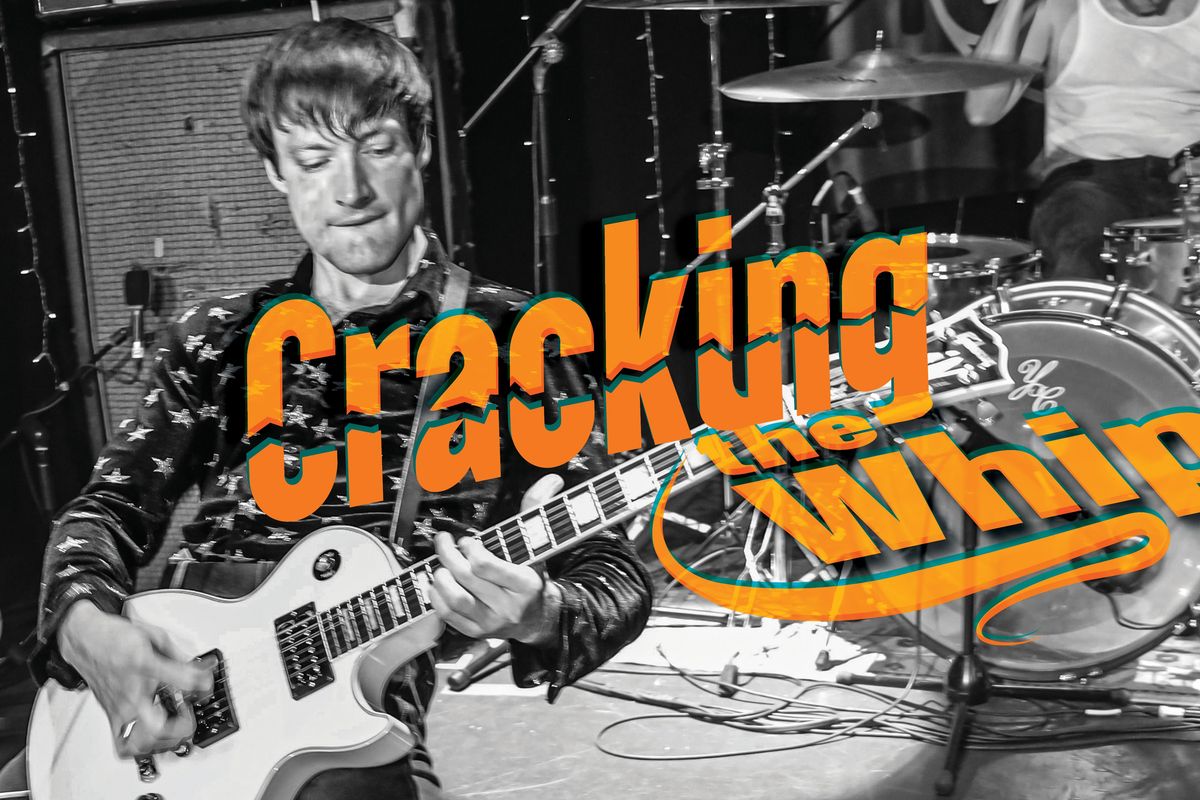
Luke Bentham, guitarist and vocalist in Hamilton, Ontario, rock outfit the Dirty Nil, was in the basement caverns under the Vatican when he glimpsed something that changed the direction of his band. It was a series of bronze reliefs by Francesco Messina, depicting the horrors of war. Amid the six pieces in the series, one in particular grabbed Bentham: It showed two men in desperate hand-to-hand combat, grappling to get control of a knife. “It was the hardest piece of art I’d seen in a very long time,” says Bentham.
YouTube
Enjoy the videos and music you love, upload original content, and share it all with friends, family, and the world on YouTube.
He and Nil co-founder and bandmate, drummer Kyle Fisher, tried to obtain the rights to use the image for the cover of their new record, The Lash, but the Vatican wasn’t having it. “We got a cease and desist from the Vatican, and their lawyers are no joke,” Bentham says with a grin.
Still, before he left, Bentham snapped a picture of Messina’s sculpture on his phone, and it hovered over the creation of The Lash like a twisted idol. “It definitely fired me up musically for some reason,” he says. “It’s rare that I’ll see something and it’ll make me want to play my guitar a certain way, but this is one instance where it came to pass that way.”
Messina’s work took Bentham somewhere vicious and primal. It pulled him back to some of the sounds the Nil had explored earlier in their 14-year career: white noise, feedback shrieks, “sheet-metal-shaking distortion.” It made Bentham think of the work of the Jesus Lizard’s Duane Denison. “Something about this cold, metallic, brutal piece of art made me play guitar a bit more angularly, and with a much higher threshold and acceptance of microphonic and horrible feedback than I’ve been looking for on our last few albums,” he says.
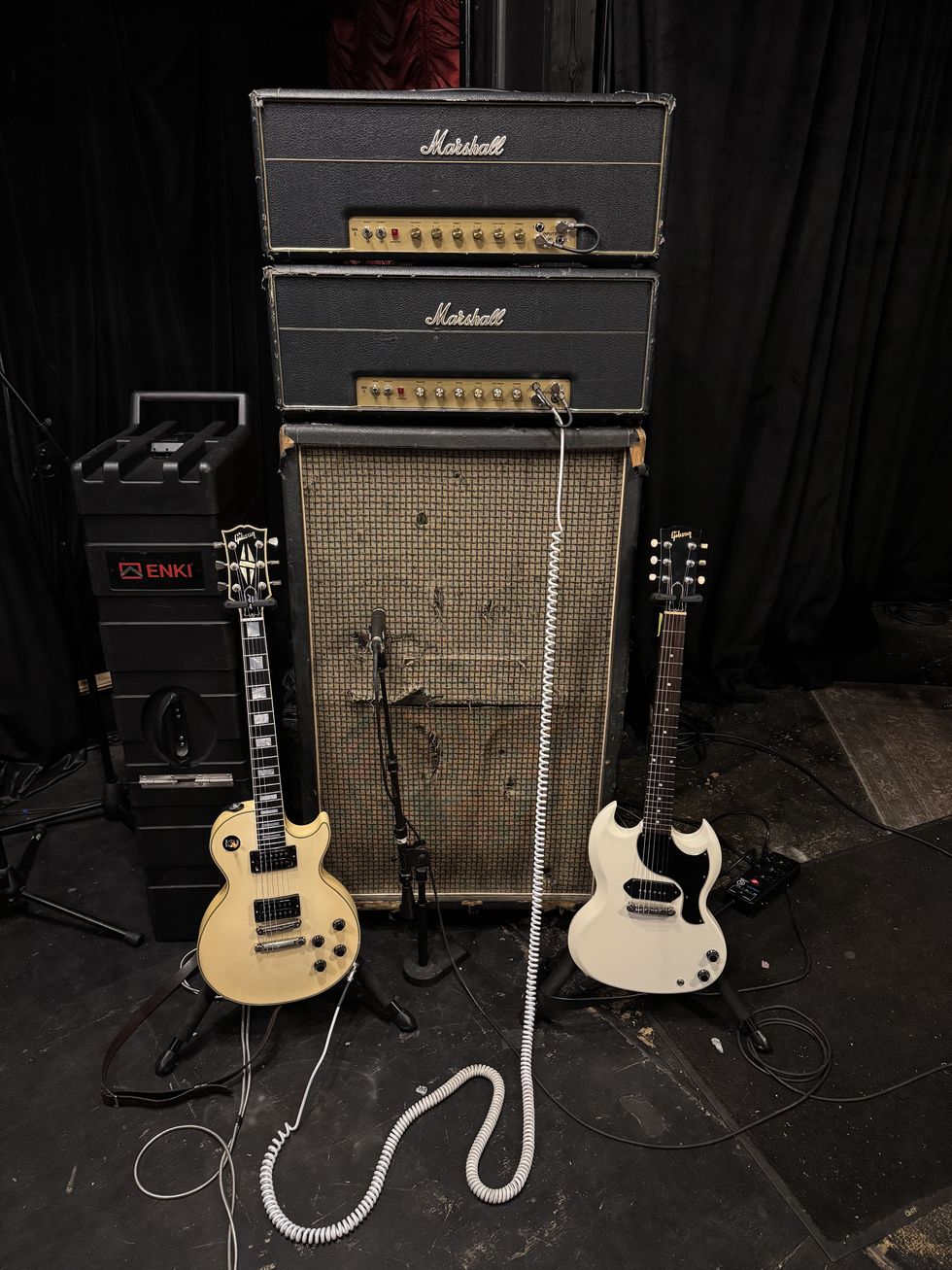
Enter The Lash, a scummy, barbwire-scraped slab of punk rock ’n’ roll, scarred with white-hot slashes of classic metal, hardcore, thrash, and garage rock. After the radio-ready melodies and tidy production of 2021’s Fuck Art and 2023’s Free Rein to Passion, The Lash feels like a triumphant return to the basement. “I’m incredibly proud of this record because we made it because we wanted to,” says Bentham. “I’m not a big believer in the idea that tension makes good records.”
“Something about this cold, metallic, brutal piece of art made me play guitar a bit more angularly, and with a much higher threshold and acceptance of microphonic and horrible feedback.”
To honor that energy and bring The Lash to life, Bentham and Fisher bailed on the higher-budget trappings of their previous records and went back to basics, working with local engineer and powerviolence musician Vince Soliveri at Boxcar Sound in Hamilton. When it came time to record Bentham’s vocals, Soliveri had a strange-looking mic set up. “I was like, ‘What’s this microphone? Is it something you like to use for vocals?’” Bentham recalls. “Vince was like, ‘I have no idea what it is. It just looked cool, so let’s try it out.’”
He continues, “I think Vince’s attitude towards that specific thing is a pretty good indicator of how we approached making this record, which was different from the 'tried and true' way we've made our last few. There are trade-offs when you enter that world, and complexities that enter your life and your band when it comes to staying in that world. With pretty much all of our previous records, there’s been some sort of behind-the-scenes animating force to make it a certain way or an internal pressure: ‘If we do this, then maybe we can get that.’ We basically decided for ourselves that we had fun, but we are leaving the casino.”
Luke Bentham’s Gear
Guitars
1975 Gibson Les Paul Custom
Shyboy T-style (studio)
1952 goldtop Gibson Les Paul (studio)
Amps
Marshall 1959SLP w/ Marshall 8x10 cabinet
Ampeg VT-22 (studio)
Fender Deluxe Reverb (studio)
Vox AC4 (studio)
Effects
Various Pro Co RAT models
Electronic Audio Experiments 0xEAE Boost
Strings & Picks
Ernie Ball Power Slinky (.011–.048)
Dunlop .73mm picks
Those “internal pressures,” which are skewered on the new track, “Rock N’ Roll Band,” were jettisoned this time. With The Lash, the philosophy was simply, “Let’s just make a record, see what happens,” Bentham says. “It’s been a long time since I found myself in that headspace, I think probably since we made ‘Fuckin’ Up Young’ and all those songs 14 years ago.”
“We basically decided for ourselves that we had fun, but we are leaving the casino.”
Still, The Lash has moments unlike anything the Nil have produced to this point. The slow, cornered-animal growl of “This is Me Warning Ya” and the haunted-house romance of “Spider Dream” are two of the record’s doglegs into the softer end of the macabre. And the stomping “That Don’t Mean It Won’t Sting,” is unexpectedly intro’d by cello and xylophone, thanks to violinist and friend Sara Danae.
Even as the band has grown, Bentham’s rig has scarcely changed. His calling-card tone for the past decade has been a 1975 Gibson Les Paul Custom, tuned to E-flat standard, through a Pro Co RAT (or two, with the second set to “drop the hammer”) and into a Marshall 1959SLP head and a Marshall 8x10 cabinet. Bentham admits he’s pretty hard on his guitars—the ’75, which has a stock pickup in the neck and an early production DiMarzio Super Distortion in the bridge, has had its headstock broken on more than one occasion.
While recording The Lash, though, Bentham changed things up. Rather than the usual RAT pedals, he leaned on the Electronic Audio Experiments 0xEAE Boost, which he describes as the most “extreme” dirt pedal he’s used to date. “That pedal is absolutely brutal,” he says with a smile. For the record’s violent feedback, Bentham and Soliveri borrowed one of producer John Goodmanson’s tricks: Split the guitar signal via an A/B box, send one signal to the amp being tracked in an isolation room, and another to a 5-watt amp in the control room. The feedback generated from the small combo jumps back through the pickups, and out to the stack in the isolation room (a Vox AC4 helped out for those purposes). For clean tones, meanwhile, Bentham called on his godfather’s 1952 Les Paul goldtop and a Shyboy Telecaster copy, both running into an Ampeg VT-22. The Ampeg’s reverb, along with the onboard effect from a Fender Deluxe Reverb, is the only coloring Bentham applied besides his dirt.
“There are so many distractions and complications as you navigate a career in music, but you must return to the simple joy of a howlingly distorted Les Paul Custom E chord as your guiding light.”
The RAT, by the way, is still Bentham’s one true love in live settings. “I’ve learned not to mess with my rig, which has served me very well for basically 12 years now,” he says. “It’s never ceased to put a smile on my face to plug into my plexi with my Custom, turn it up, and play an E chord. If that doesn’t make me happy, then I’m probably done with rock ’n’ roll, because that’s what this whole thing is. There are so many distractions and complications as you navigate a career in music, but you must return to the simple joy of a howlingly distorted Les Paul Custom E chord as your guiding light.”
YouTube
On his long-running video tutorial series Let ’er Riff, Bentham breaks down the tricks behind the foundation-shaking fury of The Lash’s opening track, “Gallop of the Hounds.
IK Releases Brown Sound 80/81
IK Multimedia releases the Brown Sound 80/81 Signature Collection for TONEX, the second part of the limited TONEX Brown Sound series. Carefully crafted to match the recorded tones of two iconic early-'80s albums, this collection features 73 precisely designed Tone Models, along with several amp-only captures that can be used with IK or 3rd-party IRs or run through a real cab live on stage.
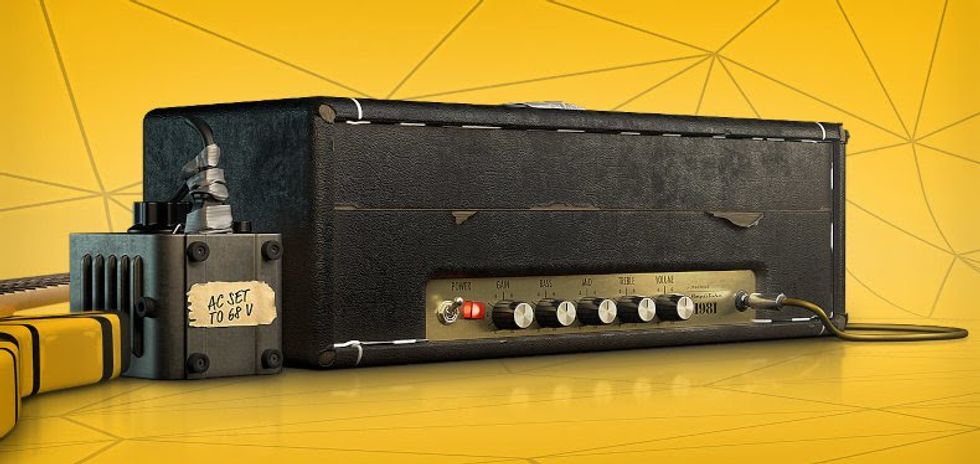
Offering both authentic recreations and thoughtful variations to reflect different theories about how these legendary tracks were recorded, the new Brown Sound collection captures the darker swagger and heavier edge that marked a milestone in the guitarist's journey.
1980 Tone Models
On the 1980 album, the tones are thicker, drier, and more saturated than on the second album, marking a return to a raw, aggressive sound that echoes the ferocity of the debut. It's more in-your-face with a noticeable midrange punch, tighter low end, and more focused articulation. It reflects a shift toward a more modern, high-gain tone, hinting at the sonic direction that would influence the next generation of rock and metal players.
1981 Tone Models
Compared to the raw brightness of 78/79, the 1981 tone is tighter and more controlled, with pronounced low-mids and a more percussive attack. There's less of the spacious, open-air feel of the earlier records, replaced by a thick, almost claustrophobic intensity that matches the album's darker vibe. The gain is higher, the reverb is dialed back, and the overall sound feels more focused, brooding, and polished, yet still unmistakable.
The Amp: "The ONE"
At the heart of the Brown Sound 80/81 collection is "The ONE" - a meticulously crafted Marshall-style amp built from the ground up with the exact same spec as the infamous 1968 Super Lead serial number #12301, including crucial mods that capture the DNA of the early brown sound like no other amp model.
Ready to Play
As with all collections in the series, these Tone Models were crafted using period-correct gear and capture techniques to recreate the middle two albums of that era genuinely. Each Tone Model reproduces the recorded album tone in exquisite detail, offering an ideal foundation for adding time-based effects-either within TONEX or through a favorite pedal.
Pricing and Availability
The Brown Sound 78/79 Signature Collection is now available via ToneNET and within any version of TONEX for Mac/PC at $/€99.99.*
- TONEX Brown Sound 78/79 – $/€99.99* - Includes 50 Tone Models.
- TONEX Brown Sound 80/81 – $/€99.99 – Includes 73 Tone Models.
- TONEX Brown Sound 82/84 – $/€79.99 pre-order (reg. $/€99.99) – Includes 77 Tone Models. Coming soon.
- TONEX ONE Brown Sound Limited Edition – $/€249.99 – Available in white, red, or yellow. Includes Brown Sound 78/79 and a choice of one other Brown Sound collection (a $/€199.98 software value). Existing Brown Sound 78/79 users will receive a $/€50 discount at the IK store.
- TONEX Brown Sound Anthology Collector's Limited Edition – $/€599.99 – Box set includes all three colors of TONEX ONE (white, red, and yellow) plus all three Brown Sound Signature Collections (78/79, 80/81, and 82/84). Limited to 200 units worldwide. Shipping soon.
*Pricing excluding taxes.
For complete details and information about the Brown Sound Anthology collections and pedals, and to hear the tones, visit:
www.ikmultimedia.com/tonex-brown-sound
What I Learned Subbing for Tony Levin

When the call came, our columnist was ready.
Perhaps, like me, you’re a fan of Tony Levin—maybe even a fan of King Crimson, Peter Gabriel, John Lennon, Paul Simon, or any of the hundreds of major artists whose albums Tony has contributed bass to. He’s the bassist on Paul Simon’s “50 Ways to Leave Your Lover,” for instance, which is a song I’ve not only listened to literally thousands of times, but one with a bass tone that is hugely influential on my sound.
So when I got an email recently asking me to fill in for Tony in Stick Men, a co-led project he has with Pat Mastelotto (Mr. Mister/King Crimson) and Markus Reuter, you might imagine there was some shock and excitement going on in my brain—feelings that had to be tamed very quickly in order to do the best job I could: literally playing Tony’s bass and Chapman Stick parts in his own band.
The initial focus was on transcribing and learning the music in a very short amount of time. The call came on Monday night, and by the time I got the song list it was Tuesday—with the only rehearsal on Thursday morning at 10 a.m. We got to chug through the tunes a few times for a couple of hours in the studio, and then the first show was Friday.
My process for learning material that isn’t charted is to immerse myself in it for as long as possible. The longer I listen, the easier it becomes to learn the notes and the forms.
This time around, I didn’t have that luxury, so the process was heavily weighted toward doing the fastest and most accurate transcription work on each song, and making detailed notes about form along the way. The music is incredibly complex and very specific in places, and even after the gigs had started—through the six shows we played over three nights—I was getting notes from Markus and Pat about where we could improve, make little tweaks, and make the show better.
“You have to summon all the experience and confidence you have to keep a level head and not let the situation get the better of you.”
I found the big key was having to maintain my huge respect for Tony and for the music while trying to put aside the “hero” aspect of how he fits into my life. I didn’t have any kind of personal relationship with Tony up until this point. We’d only met a couple of times over the years. The photo that accompanies this story is from 2011, I believe, at S.I.R. Studios in Los Angeles.
But as an influence and a presence in my playing, he’s kind of been there the whole time I’ve been a bass player. To suddenly be sitting in the seat of one of your heroes can bring in some thoughts that might not serve you that well when it comes to giving the music 100 percent of your focus.
There was also this added challenge not often encountered by bass players, where I had to play a significant amount of melodic and upper-register material. This is due to Tony playing a Chapman Stick in the band, and the concept between Tony and Markus being that either of them can play melody or bass parts and trade off at any time.
Effects were a huge part of the success of the gig, and it took almost as much time to build the pedalboard as it did to learn the music.
Even after locking in what I thought would work for the shows—and falling in love with one of my old Sovtek Big Muffs all over again—I came back from the rehearsal and threw the Big Muff in a parallel loop because it was draining a little too much of the low end when I got in the room with the band. That’s a huge part of effects that I don’t think we give enough attention to. We work so long dialing in sounds at home or in the studio, but the reality of the gig—and the changing conditions from night to night and stage to stage—is always so different from that controlled home setup.
So, I learned three big things from this incredible experience:
- You never know when the call is going to come, and you need to be ready at all times.
- You have to summon all the experience and confidence you have to keep a level head and not let the situation get the better of you.
- Never commit to a signal chain in the pedalboard until you’ve heard all the sounds in the live context of the band you’re playing with.
Electro-Harmonix Oceans Abyss Review
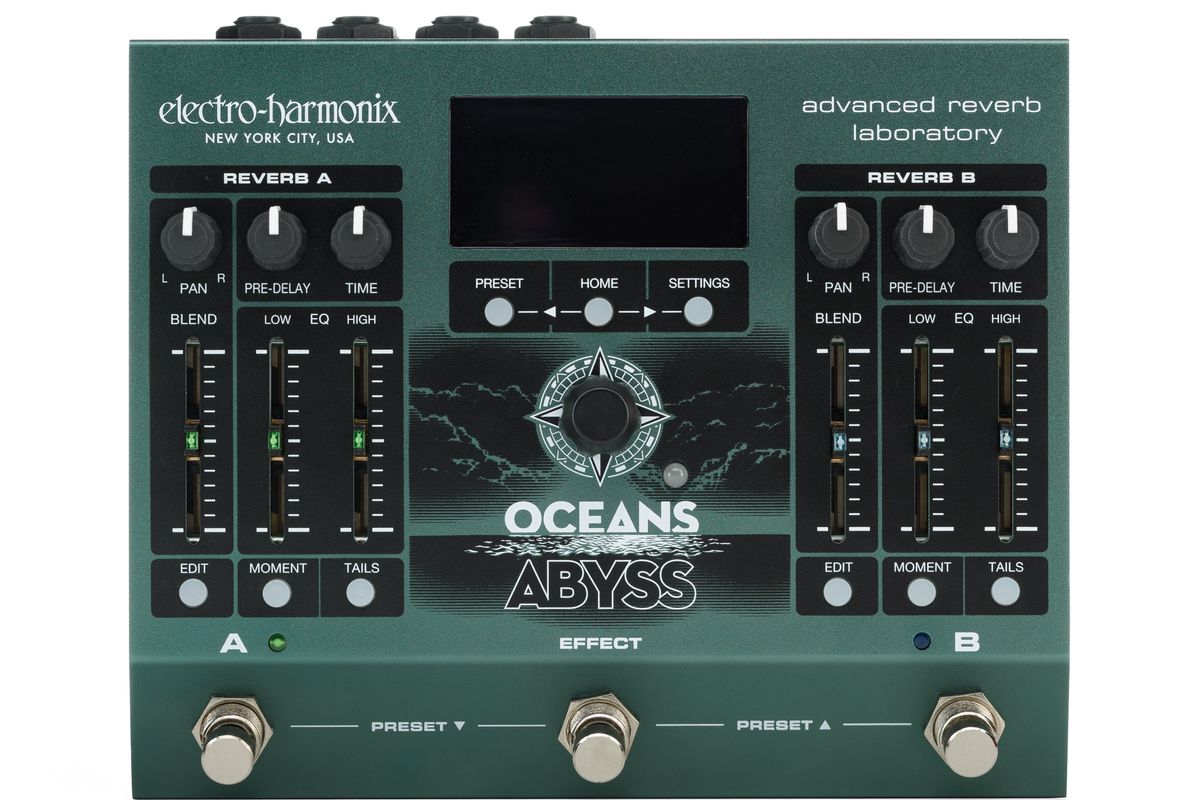
Abyss is right. Electro-Harmonix’s Ocean’s Abyss, with two stereo reverbs and 10 reverb types, is fundamentally a reverb pedal. But it is deeper than that. Much, much deeper. EHX calls the Abyss an Advanced Reverb Laboratory. I’d venture that it is more like a reverb-centric multieffects unit, because the Oceans Abyss enables you to add effects that include chorus, distortion, delay, and bit-crushing to the expansive array of reverbs. But I’m not even sure my modified description does the pedal justice. It is a sound-design machine of impressive power—especially if you have the time and will to explore the breadth of its functions.
For a pedal that makes so many sounds, the Oceans Abyss’ control layout is fairly straight ahead, and compared to some of EHX's other superpedals it’s actually downright economical. The center screen displays a virtual pedalboard where you can manipulate effects and signal routing via a control knob and just a few buttons. The reverb controls themselves, meanwhile, are easy to tailor via a knob-switch-and-slider array that enables adjustment of effects blend, EQ, pre-delay, reverb time, pan position in a stereo field, and more. The input/output array is capable but straightforward, with stereo I/O, effects send and return, plus MIDI, USB, and expression-pedal capability.
Deep Diving
The individual reverb sounds in the Abyss are excellent, which, given my experience with previous Oceans-series reverb pedals, is what I would expect. The more complex factory presets range from weird-but-inspiring to verging on impractical. But the simpler reverbs exude elegance. Even the other built-in effects are incredible. I got delightfully lost in the bit crusher for some time, dialing in a very interesting and buzzy fuzz tone.
“The simpler reverbs exude elegance.”
The factory presets are great jumping-off spots and rewarding to use. But to take full advantage of the pedal’s capabilities—and, perhaps, to justify the lofty $495 price—you’ll need to spend significant time with the Abyss and its manual. Creating and editing presets (you can save up to 128) isn’t always intuitive. For many users, customization will be easier using the available desktop patch editor or the not-yet-available EHX patch editor app. Even power users may be hard-pressed to utilize all of the Abyss’ capabilities. I am anxious now, knowing that somewhere in my house the Oceans Abyss is flashing red—still signaling intolerance of my refusal to fully commit to a pre-delay time.
In name, function, and price, the Ocean’s Abyss is much more than its predecessor, Oceans 12. It’s seemingly infinite, endless in every direction. Whether it’s a fit for you will come down to your appetite for exploration and study, and the scale of your musical ambitions.
.rbm-pick-card { --rbm-border: #88e89e; --rbm-accent: #000000; border: 2px solid var(--rbm-border, #e53e3e); border-radius: 10px; padding: 16px; background: #fff; font-family: inherit; position: relative; } .rbm-pick-badge { position: absolute; top: -10px; left: 12px; background: var(--rbm-accent, #e53e3e); color: #fff; font-size: 12px; line-height: 1; padding: 6px 10px; border-radius: 6px; font-weight: 700; } .rbm-pick-wrap { display: grid; grid-template-columns: 110px 1fr; gap: 16px; align-items: start; } .rbm-pick-img { aspect-ratio: 1 / 1; /* forces square crop */ overflow: hidden; border-radius: 6px; background: #f3f4f6; /* subtle placeholder */ } .rbm-pick-img img { width: 100%; height: 100%; object-fit: cover; /* crops without distortion */ display: block; } .rbm-pick-title { margin: 0 0 4px; font-size: 20px; font-weight: 800; color: #111; } .rbm-pick-sub { margin: 0 0 12px; font-size: 14px; font-weight: 700; color: #334155; } .rbm-pick-btns { display: grid; gap: 10px; max-width: 560px; } .rbm-pick-btns a { display: block; text-align: center; background: #000; color: #fff !important; text-decoration: none; padding: 12px 14px; border-radius: 8px; font-weight: 800; letter-spacing: .3px; } .rbm-pick-btns a span.price { text-transform: none; } .rbm-pick-btns a span.label { text-transform: uppercase; } /* Responsive */ @media (max-width: 560px) { .rbm-pick-wrap { grid-template-columns: 80px 1fr; } .rbm-pick-title { font-size: 18px; } }
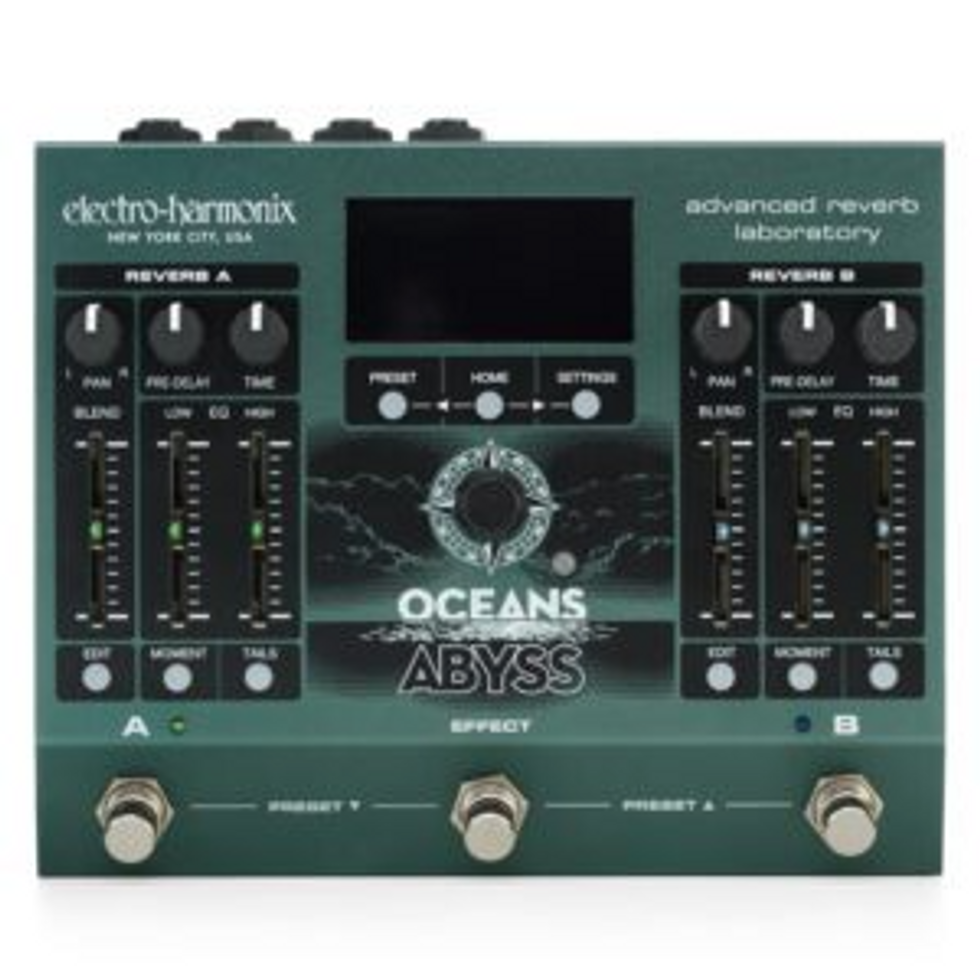
Electro-Harmonix Oceans Abyss Review
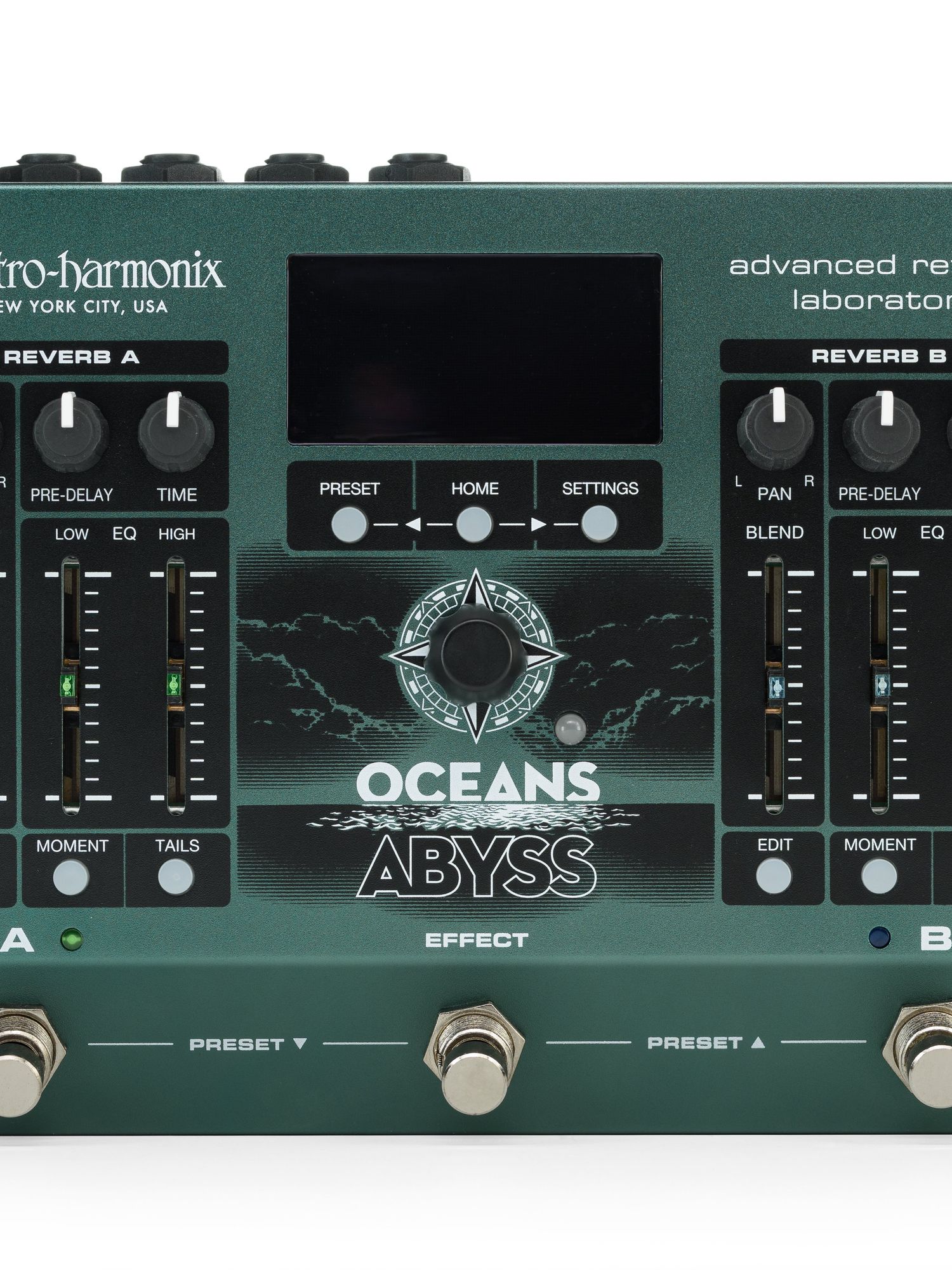
Abyss is right. Electro-Harmonix’s Ocean’s Abyss, with two stereo reverbs and 10 reverb types, is fundamentally a reverb pedal. But it is deeper than that. Much, much deeper. EHX calls the Abyss an Advanced Reverb Laboratory. I’d venture that it is more like a reverb-centric multieffects unit, because the Oceans Abyss enables you to add effects that include chorus, distortion, delay, and bit-crushing to the expansive array of reverbs. But I’m not even sure my modified description does the pedal justice. It is a sound-design machine of impressive power—especially if you have the time and will to explore the breadth of its functions.
For a pedal that makes so many sounds, the Oceans Abyss’ control layout is fairly straight ahead, and compared to some of EHX's other superpedals it’s actually downright economical. The center screen displays a virtual pedalboard where you can manipulate effects and signal routing via a control knob and just a few buttons. The reverb controls themselves, meanwhile, are easy to tailor via a knob-switch-and-slider array that enables adjustment of effects blend, EQ, pre-delay, reverb time, pan position in a stereo field, and more. The input/output array is capable but straightforward, with stereo I/O, effects send and return, plus MIDI, USB, and expression-pedal capability.
Deep Diving
The individual reverb sounds in the Abyss are excellent, which, given my experience with previous Oceans-series reverb pedals, is what I would expect. The more complex factory presets range from weird-but-inspiring to verging on impractical. But the simpler reverbs exude elegance. Even the other built-in effects are incredible. I got delightfully lost in the bit crusher for some time, dialing in a very interesting and buzzy fuzz tone.
“The simpler reverbs exude elegance.”
The factory presets are great jumping-off spots and rewarding to use. But to take full advantage of the pedal’s capabilities—and, perhaps, to justify the lofty $495 price—you’ll need to spend significant time with the Abyss and its manual. Creating and editing presets (you can save up to 128) isn’t always intuitive. For many users, customization will be easier using the available desktop patch editor or the not-yet-available EHX patch editor app. Even power users may be hard-pressed to utilize all of the Abyss’ capabilities. I am anxious now, knowing that somewhere in my house the Oceans Abyss is flashing red—still signaling intolerance of my refusal to fully commit to a pre-delay time.
In name, function, and price, the Ocean’s Abyss is much more than its predecessor, Oceans 12. It’s seemingly infinite, endless in every direction. Whether it’s a fit for you will come down to your appetite for exploration and study, and the scale of your musical ambitions.
MONO Releases the M80 Classic Ultra Gig Bag
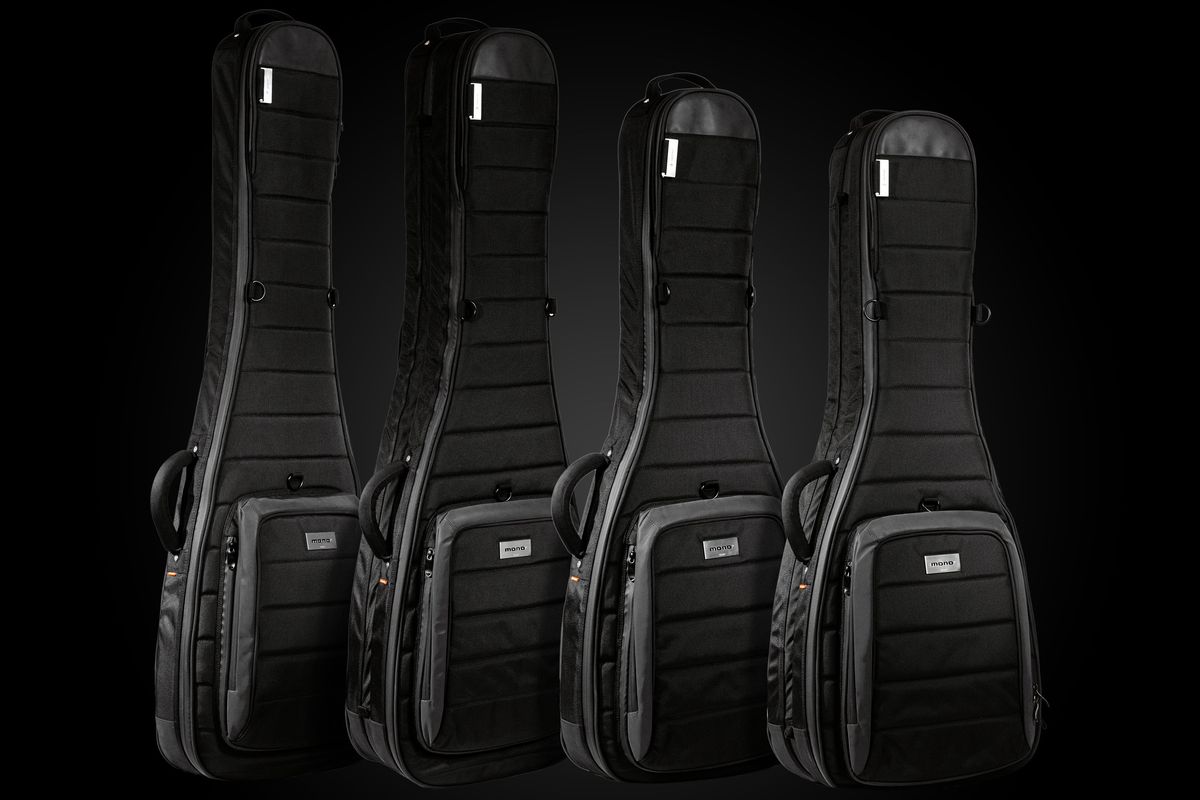
MONO has introduced the M80 Classic Ultra – the latest evolution of the company’s sleek, iconic gig bag, now enhanced with smarter storage, effortless mobility, and tougher protection.
Building on the innovation of the original M80, the Classic Ultra features a refined silhouette and thoughtful upgrades designed to make life on the move easier for gigging musicians, touring professionals, and everyday players alike.
At the core of the Classic Ultra is the patented Freeride® Wheel System, allowing users to attach wheels for seamless transport when navigating airports, sidewalks, or venues. The system is especially impactful on Dual models, lightening the load while moving two instruments at once. Storage has also been supercharged. A newly designed expandable front pocket offers more room for tools and gigging essentials, while built-in compartments help keep everything in place. For even more capacity, the Classic Ultra case is Tick-ready and compatible with the MONO Tick 2.0 and Tick+ 2.0 Accessory Cases.
Inside, the instrument is protected by the Headlock® neck suspension system, keeping it securely in place and shielded from impact. A discreet tracker tag-compatible pouch adds peace of mind for travel. The exterior is built tough with water-resistant 1680D ballistic nylon, waterproof zipper tape, and reflective strips for added safety.
Key Features of the M80 Classic Ultra:
- The patented Freeride® Wheel System allows users to seamlessly attach wheels to the case, providing smooth and effortless mobility.
- Expanded smart storage includes dedicated internal compartments and an expandable front pocket, offering ample space for tools and gigging essentials.
- The case is Tick-ready, fully compatible with MONO’s Tick 2.0 and Tick+ 2.0 Accessory Cases for even greater storage flexibility.
- The signature Headlock® neck suspension system keeps your instrument securely in place, now enhanced with a discreet pouch designed to hold a tracker tag.
- The durable exterior is constructed from water-resistant 1680D ballistic nylon and features waterproof zipper tape and reflective detailing for added protection and visibility.
The Classic Ultra is available in versions for guitar, bass, dual guitar, and dual bass, ensuring a fit for every player’s needs.
The MONO M80 Classic Ultra carries street prices of $359.99 (Guitar/Bass) and $459.99 (Dual Guitar/Bass) and is available via monocreators.com and select authorized dealers worldwide.
Aclam Go Rocky Go Review
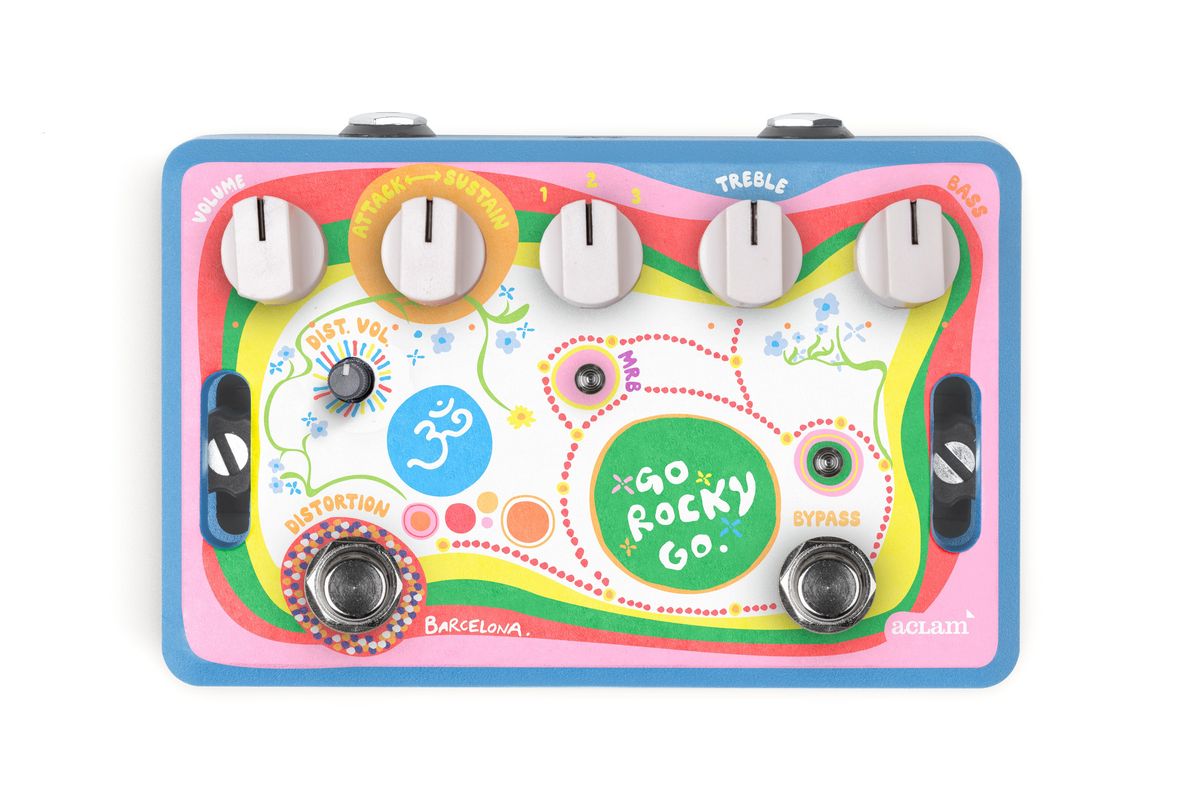
In electric guitar terms, I’ve always thought the Beatles are pretty underrated as tone meisters. We all know how good the records sound as complete works. But you rarely encounter rabid enthusiasm for the guitar tones themselves. Holy cow, though, I adore them. The electric tones that shape their 1966-’68 LPs are among the most beautiful, thrilling, and influential forces in my life. Barcelona company Aclam shares my sentiments, apparently. To date, the company built the Dr. Robert, which honored the sounds of the Vox UL730s on Revolver and Sgt. Pepper, and the Mocker, which aped the fuzz circuit from that amp.
Aclam’s latest, the Go Rocky Go, pays homage to another Vox amp that graced Abbey Road in those groundbreaking years: the Conqueror. The Conqueror left a less distinct, less well-chronicled mark on the Beatles' work than the UL730s or UL7120s. But it was definitely a part of The Beatles recording sessions (you can clearly hear the amp’s “MRB” selector at the end of “Birthday”) and is the likely source of many sounds on Magical Mystery Tour. Aclam’s Go Rocky Go dishes many fantastic Conqueror tones, and it’s dripping with psychedelic-era Beatles-ness—especially if you enjoy the more aggressive and distorted sounds from that period.
Magical Mystery Re-Routes
Aclam say they reproduced the Conqueror’s preamp topology part-for-part using an original Conqueror specimen (serial number 2004) as reference. With the MRB switch and distortion, they recreated much of the Conqueror’s functionality. There are a few significant differences, however. Aclam recreated the 2-channel amp’s brilliant channel exclusively. They added a second gain stage called the crunch channel, which splits the difference between the standard and distortion channel’s gain profiles. Aclam also made the bass pot more linear and precise than the amp’s. And unlike the Conqueror, the distortion circuit has its own output-level control.
Heavy Tripping the Light Fantastic
Though the Go Rocky Go will summon compelling tones from any guitar/amp combination, its basic voice is a natural fit for humbuckers and an EL84 amp. And depending on where you set the tone controls, it adds midrange focus and top-end running from sparkly to vicious. Black-panel Fender amps are less easily flattered by the humbucker/Rocky combo, but those tones can be carved into very precise, high-mid rhythm and lead sounds. With Fender single-coils, too, EL84s are a more organic match, but I’d be psyched to record with many of the hyper-focused high-mid sounds from the Go Rocky Go and a Fender guitar-and-amp pairing.
Adding the MRB switch to the mix (by pressing both footswitches) boosts either the 500, 700, and 1k MHz frequencies, just like three positions on a wah. Ostensibly, this narrows the pedal’s range. But the single-coil/Rocky tones with both Fender and EL84 amps are fascinating, generating sounds that would positively pop in mixes. Humbuckers seemed to summon the best from the MRB settings in both amp types—coaxing uniquely focused and burly midrange tones.
“You might think you know this distortion from Beatles records, but in the flesh it’s something much more substantial.”
Given the Beatles’ legacy as masters of pop, it’s easy to forget how tough they could be, and the Go Rocky Go gleefully, colorfully embodies that facet of the band’s personality in the distortion section. With any guitar and amp combination these sounds are snarly, nasty, and biting, but also massive. You might think you know this distortion from Beatles records, but in the flesh it’s something much more substantial. And while 6L6- or EL34-type distortion might be more even and full-spectrum in harmonic terms, the Go Rocky Go delivers a wicked, room-filling punch.
For a specialized pedal, $348 is a big investment. Listen with open ears and mind, though, and you’ll hear scads of different and brilliant tone colors in this stomp, including many that—surprise!—would benefit and intrigue curious and intrepid studio artists. In my humble opinion, Go Rocky Go is a ripper. But ’66-’68 Beatles tones may not be everyone’s ideal, and though often muscular and hard-hitting, they dwell some distance from Marshall or Fender archetypes. That, however, is the beauty of the Go Rocky Go, and if it’s good enough for the Fabs, it’s good enough for me.
PG's Editorial Director Reflects on His Decade at the Magazine
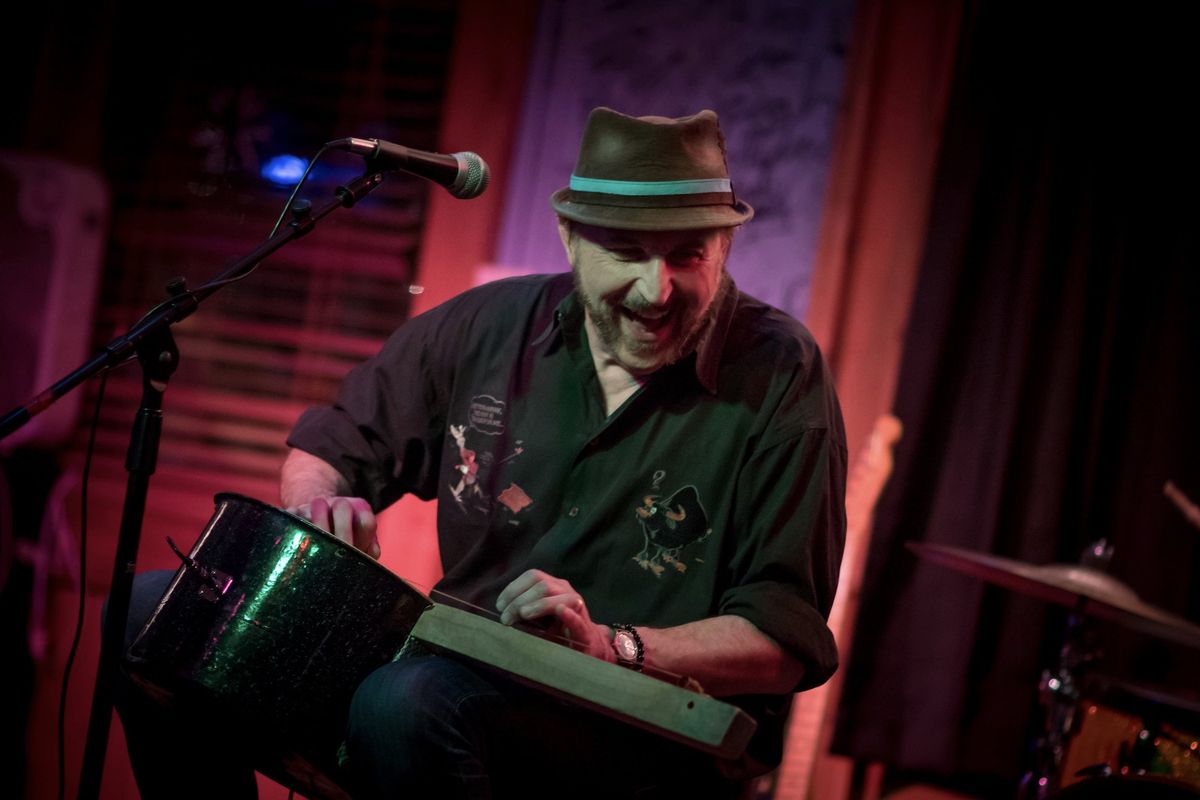
Ted Drozdowski considers his time at his favorite guitar magazine, his life in music and journalism, and what the future holds as he retires.
I’ve truly enjoyed sharing stories and ideas with you these past few years, and value the time I’ve been able to spend with every member of the Premier Guitar community. But—even though horses make me a little anxious—it’s time to ride on down the road. Not into the sunset, though. You can expect to see my byline in future issues and still drop me a line at my email address here. Or you can connect with me on social media and join me in my creative exploits, where I will continue to chase music and the adventures it brings.
I’ve been at Premier Guitar for a decade now, and have served as editorial director for most of the past three years, so this decision doesn’t come lightly. I’ve been able to do a lot of work here that I’m proud of, from interviewing artists ranging from Carlos Santana to the Messthetics, to writing odes to personal heroes like R.L. Burnside and Sonny Sharrock, to gently guiding the magazine in a direction that I hope has served you well and will continue to do so under the leadership of my colleague and friend Richard Bienstock. Rich and I met when I was writing for him at Guitar World and Guitar Aficionado years ago, and more recently he’s taken to writing for us here at PG. The wheel turns. Rich is an exceptional editor and I know you will enjoy what he brings.
“You can never have enough friends in this life. And the ones who inspire and encourage you are especially precious.”
Will I miss feeling the pulse of exciting new gear and music on a daily basis? Sure! But after 47 years as a music journalist, I won’t miss the perpetual deadlines—or the tyranny of the alarm clock! I have a long list of personal musical projects to shepherd and pursue—most prominently the feature film The River: A Songwriter’s Stories of the South, which I made with my cosmic roots band Coyote Motel. It’s a psychedelic musical cultural history that is plucked from the pages of my interests and life over the past 30 years. In a final shameless plug within these pages, it is available on several streaming outlets now and as a DVD, and I urge you to satisfy any curiosity you might have about me and my musical interests—think David Gilmour and Sonny Sharrock meeting R.L. Burnside, the Band, and Son House at the intersection of highways 61 and 49.
Speaking of community, which I value greatly, one of the most wonderful things my time at PG has allowed me to do is reconnect with guitarists and other musicians I’d fallen out of step with during the years I was breathlessly freelance writing and ripping around the U.S. and parts of Europe with my earlier bands. Like touring, it’s also allowed me to make many wonderful new friends, from readers who‘ve exchanged emails with me and come to my gigs (you know who you are—thank you!) to artists whose art and personalities have inspired and delighted me, and with whom I’ve grown close. That is certainly something that I hope continues, because you can never have enough friends in this life. And the ones who influence and encourage you are especially precious.
Finally, I’d like to compliment my colleagues in every department of this magazine. They are a tight-knit bunch with myriad skills, and it’s been a pleasure working with them. Many of them are damn fine guitar players, too. Premier Guitar is not part of an international publishing conglomerate. It is an independent business that has stood the test of time, the challenges of Covid, and now the economic uncertainties that each day’s headlines seem to bring. It’s been an honor, my friends—and for me, a beautiful way to bring my journalism career to a crescendo. Although, once again, not a finale.
Now, if you’ll excuse me, I’m heading to the beach.
Fender Partners With Third Man, Unveiling Accessories & Apparel Collection
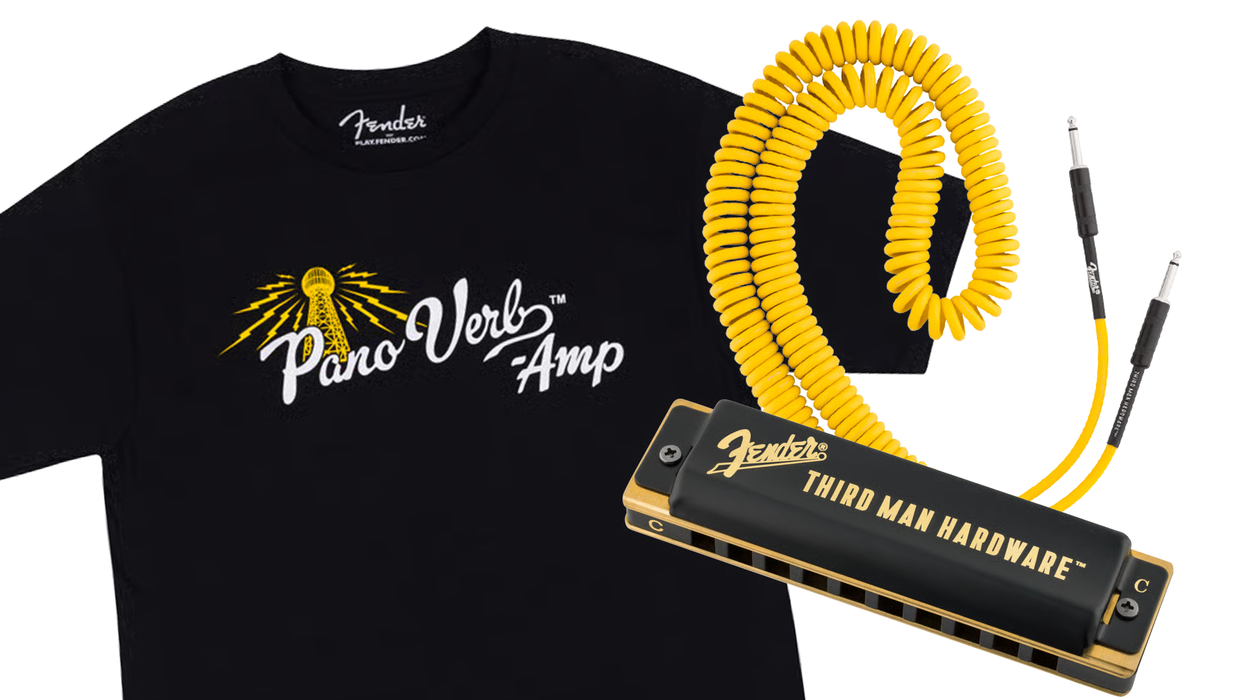
Inspired by Third Man’s raw, gritty aesthetic and strikingly vibrant yellow-on-black colour palette, the Fender x Third Man Hardware Collection embodies the unmistakable style that has defined Jack White’s artistry from his time as founder of the White Stripes, all the way through to his work with The Raconteurs and The Dead Weather and more recently, his ventures as a solo musician.
With products ranging from a tee and hoodie to a gold-etched harmonica and Mini Jack Rack inspired by the Pano Verb™ Amp, the collaboration showcases Jack White and Third Man’s boundary-pushing creativity and innovation.
“Our co-branded apparel and accessories collection brings a vintage flair that speaks to Jack White’s storied legacy and continued creativity,” said Jordan Gruver, Senior Product Manager of Accessories at Fender. “It’s been a pleasure tapping into Third Man’s bold image to create a collection that amplifies the timeless appeal and vibrant style of the iconic label and record store.”
“This collaboration with Fender is more than just accessories — it’s a meeting of legacy and style,” said Christina Inman, Director of Merchandising at Third Man Records. “Third Man Hardware is proud to inject our signature style and look into tools that speak to the hands of creators everywhere.”
Fender® x Third Man Hardware™ Mini Jack Rack
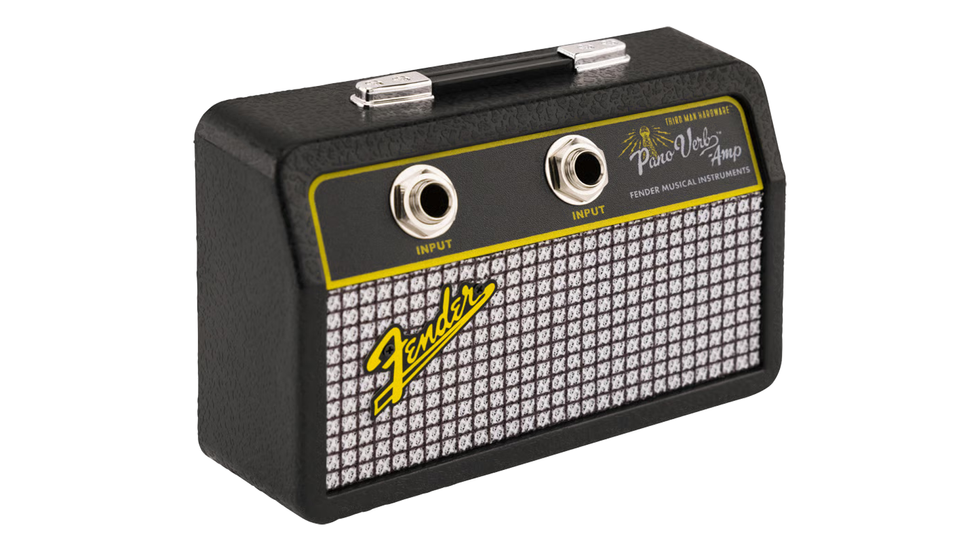
($29.99, €39.99 EUR, £33.99 GBP, $49.00 AUD, ¥4,950 JPY)
The Thirdman Hardware™ Mini Jack Rack is wall-mounted and turns your keychain into part of your rig. Comes with real 1/4” input-style keychains that plug in just like a guitar cable – perfect for the studio, the jam room, or anywhere you want a little more tone in your home.
Fender® x Third Man Hardware™ Lapel Pin Set
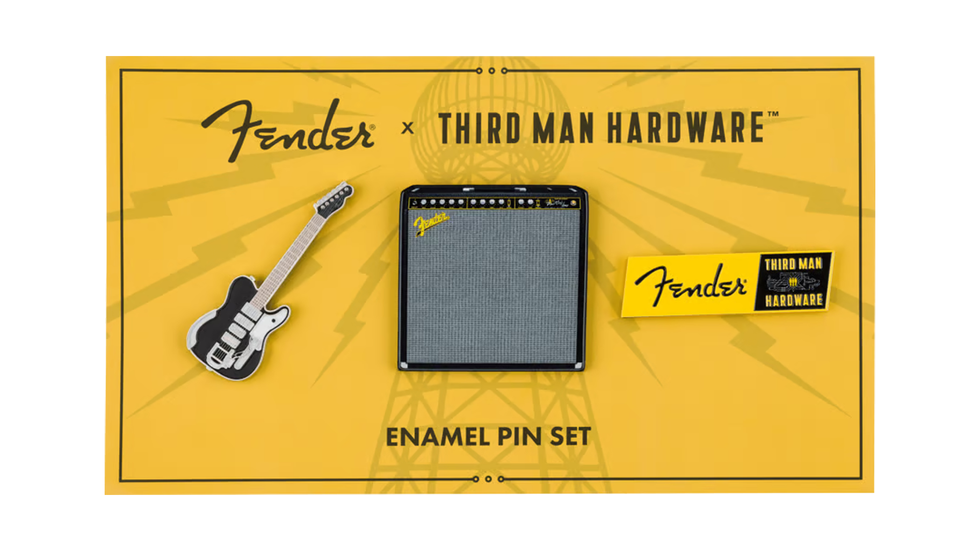
($24.99, €28.99 EUR, £23.99 GBP, $45.00 AUD, ¥4,180 JPY)
The Thirdman Hardware™ Lapel Pin set brings the raw, analog energy of Fender® and Third Man Hardware™ into your everyday fit. Featuring bold designs inspired by the iconic Pano Verb™Amp and signature Jack White Triplecaster™Telecaster®, these pins are built for fans who live and breathe the sound.
Fender® x Third Man Hardware™ Leather Strap
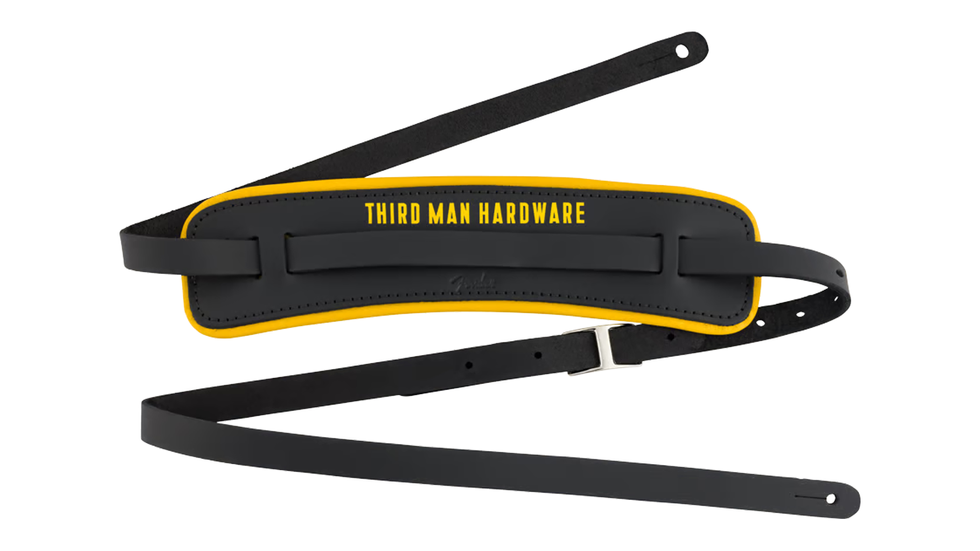
($59.99 USD, €66.99 EUR, £55.99 GBP, $110.00 AUD, ¥8,800 JPY)
Add retro-inspired style to your guitar with the Fender® x Third Man Hardware™ Leather Strap. Made from premium full-grain leather, this 2.5” wide strap features ample padding for maximum playing comfort. Drawing inspiration from Third Man’s iconic aesthetic, the strap’s bold yellow trim and Third Man Hardware logo deliver a vintage flair and timeless appeal. Whether you’re on stage or in the studio, this strap brings a touch of Jack White’s legendary look to your performance.
Fender® x Third Man Hardware™ Harmonica
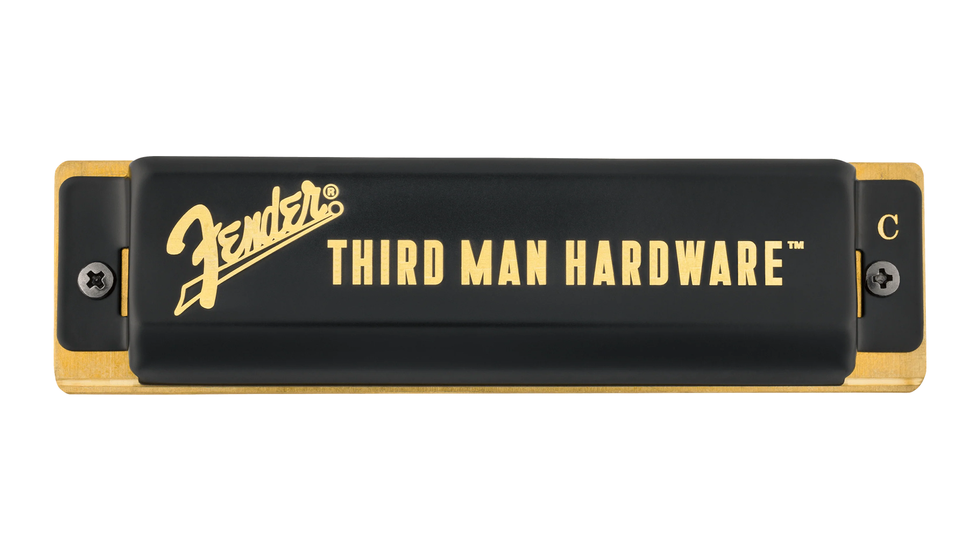
($ 41.99 USD, €47.99 EUR, £39.99 GBP, $85.00 AUD, ¥7,700 JPY)
Add retro-inspired style to your sound with the Fender® x Third Man Hardware™ Harmonica. Designed for everyday players, this 10-hole diatonic harmonica features phosphor bronze reeds for bright, bold tone and a moisture-resistant ABS comb for long-lasting reliability. Drawing inspiration from Third Man’s iconic aesthetic, its sleek gold-etched casing, and Third Man Hardware logo deliver vintage flair and timeless appeal. Bring a touch of Jack White’s legendary look to your performance with the Fender x Third Man Harmonica.
Fender® x Third Man Hardware™ 30’ Coil Cable
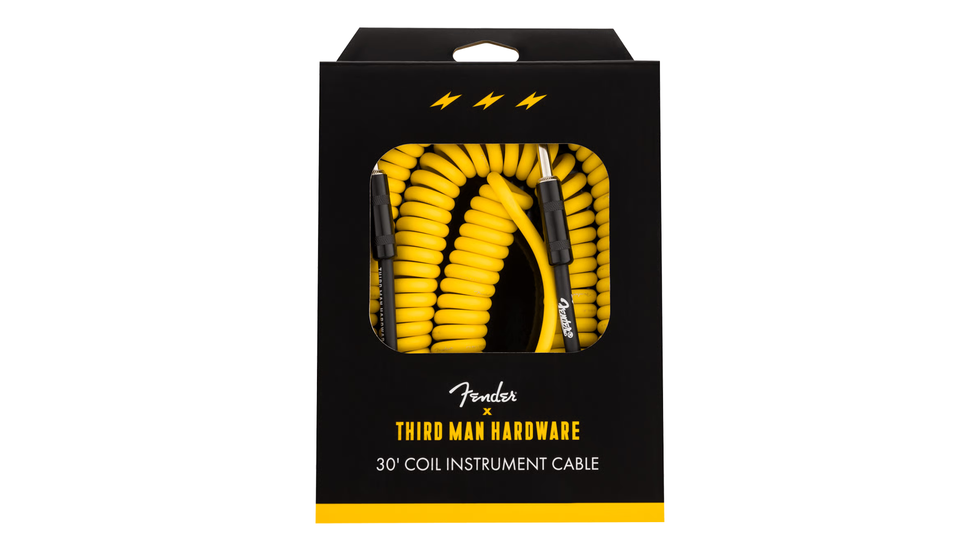
($62.99 USD, €51.99 EUR ,£43.99 GBP, $125.00 AUD, ¥6,600 JPY)
The Fender® x Third Man Hardware™ 30’ Coil Cable combines high-performance design with retro-inspired style. Featuring spiral shielding and durable nickel-plated connectors, this cable delivers reliability in the studio or on stage. Drawing inspiration from Third Man’s bold aesthetic, the cable features a striking yellow PVC jacket and custom ends featuring the Third Man Hardware logo, adding a vintage flair to your setup.
Fender® x Third Man Hardware™ Strap Blocks
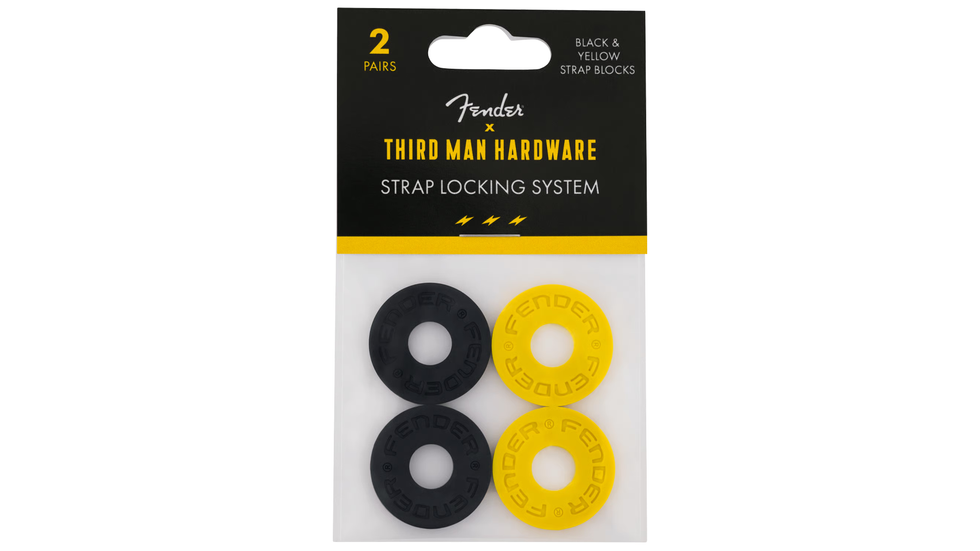
($5.99 USD, €9.99 EUR, £7.99 GBP, $8.00 AUD, ¥880 JPY)
The Fender® x Third Man Hardware™ Strap Blocks deliver the ultimate in strap security with unmistakable style. The most reliable and hassle-free instrument strap lock system ever devised. No need to remove or replace existing strap buttons on your guitar; just slip a Strap Block over the existing strap buttons and that’s it - you’re ready to go, with your strap locked securely in place.
Each package includes two complete sets: one in classic black and one in bold yellow, giving you the freedom to mix, match, or outfit two Instruments.
Fender® x Third Man Hardware™ Tee
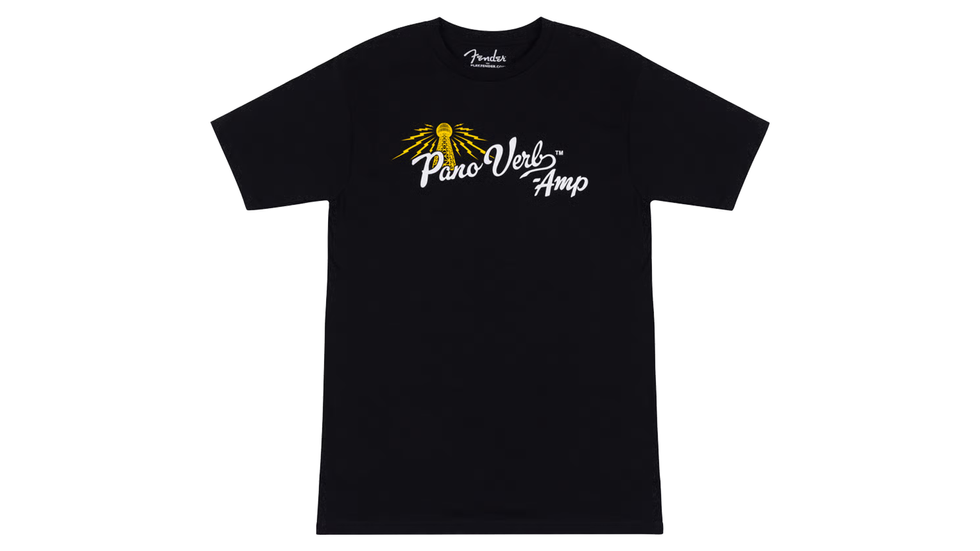
($31.99, €32.99 EUR, £27.99 GBP, $49.00 AUD, ¥6,600 JPY)
Third Man Hardware™ and Fender® join forces on this standout tee, showcasing the notable Pano Verb™ Amp graphic up front and a co-branded logo across the back. Built for the stage, the street, or the studio. Sizes: S – XXL
Fender® x Third Man Hardware™ Hoodie

($72.99 USD, €73.99 EUR, £61.99 GBP, $110.00 AUD, ¥13,200 JPY)
Third Man Hardware™ and Fender® join forces on this standout hoodie, showcasing the notable Pano Verb™ Amp graphic up front and a co-branded logo across the back. Built for the stage, the street, or the studio. Sizes: S – XXL
Testament Announce New Album Para Bellum + Release Music Video For 'Infanticide A.I.'

Bay Area thrash metal icons TESTAMENT returns this Fall with their fourteenth studio album, Para Bellum. The album which will be released on October 10th via Nuclear Blast Records stands as both a battle cry and an observation of humanity's uneasy alliance with its own creations. As technology accelerates and disconnection grows, Para Bellum sees TESTAMENT reflecting the modern chaos through music that’s urgent, sharp, and unflinchingly human.

Today, TESTAMENT deliver one of their most intense songs they've written to date, 'Infanticide A.I.'. Lead by the blinding speed of their new drummer Chris Dovas, the band shows off its musical talent far beyond their expected norms. Watch the music video for 'Infanticide A.I.'' directed by Joey Durango, here: https://youtu.be/Gtw3lcQvyPU
TESTAMENT's Chuck Billy comments, "The new album Para Bellum consists of some fast, heavy and melodic tunes. Once again Peterson has found a way to keep the song writing fresh and modern sounding. It’s gonna be hard to choose what songs to play live cause to many to choose from."
TESTAMENT's Eric Peterson states, "It’s been 5 years since our last record Titans Of Creation was released. Since then, we all waited to get back to it and we all did in a big way! Now our long over due new record Para Bellum is upon us and about to be released in October. We are super stoked and excited to release new blood and fury to you all! With our first single 'Infanticide A.I.' we’re coming out swinging! But with new velocities of fury, while maintaining a balance that we all love and know from a Testament track, enjoy!"

Para Bellum Tracklisting
1. For the Love of Pain
2. Infanticide A.I.
3. Shadow People
4. Meant to Be
5. High Noon
6. Witch Hunt
7. Nature of the Beast
8. Room 117
9. Havana Syndrome
10. Para Bellum
Para Bellum is now available for pre-order in the following formats:
- CD Jewel, 20 pg Booklet
- Gold Cassette (Band/King's Road Exclusive - Limited)
- 2 LP Gatefold, 16 pg Booklet
- Yellow, Black & Brown Splatter (Band/King's Road Exclusive - Limited)
- Copper (Mass Market Retail (US/EU))
- Bone & Brown Marbled (NB Europe Exclusive)
- Black and Orange Swirl + Splatter (NB Europe Exclusive)
- Orange & Black Swirl (NB U.S. Exclusive)
Para Bellum was recorded with Juan Urteaga, mixed by Jens Bogren at Fascination Street Studios, and was mastered by Tony Lindgren at Fascination Street Studios. The album is extremely polished and operating at full throttle. The band once again enlisted Eliran Kantor to create the album artwork. In an era flooded by AI-generated imagery. the hand painted creation encapsulates the album’s essence: a serene angel made of missiles, an explosion turned halo, surrounded by shovel-bearing cultists with books strapped to their faces.
From first note to last breath, Para Bellum is an album by warriors—crafted in chaos, and built to outlast the wars to come!
TESTAMENT live dates:
Latin America Tour
08.21.2025 BR Brasília @ Toinha Brasil Show
08.23.2025 BR Rio De Janeiro @ Circo Voador
08.24.2025 BR São Paulo @ Carioca Club
US Festivals
09.21.2025 US Louisville, KY @ Louder Than Life 2025
10.03.2025 US Sacramento, CA @ Aftershock 2025
European Tour
10.05.2025 DE Hannover @ Capitol
10.07.2025 UK Bristol @ Beacon
10.08.2025 UK Birmingham @ O2 Academy Birmingham
10.09.2025 IE Dublin @ Olympia Theatre
10.10.2025 UK Manchester @ Manchester Academy
10.11.2025 UK London @ O2 Forum Kentish Town
10.12.2025 BE Antwerp @ Trix
10.13.2025 DE Stuttgart @ LKA Longhorn
10.14.2025 DE Hamburg @ Große Freiheit 36
10.16.2025 CH Pratteln @ Z7 Konzertfabrik
10.17.2025 DE Wiesbaden @ Schlachthof
10.18.2025 IT Milan @ Live Club
10.19.2025 DE Saarbruecken @ Garage
10.21.2025 SI Ljubljana @ Media Center
10.22.2025 AT Vienna @ Arena
10.23.2025 PL Wroclaw @ A2
10.24.2025 DE Munich @ TonHalle
10.25.2025 DE Oberhausen @ Turbinenhalle
10.26.2025 NL Utrecht @ Tivoli Vredenburg - Ronda
TESTAMENT is:
Chuck Billy | Vocals
Eric Peterson | Guitar
Alex Skolnick | Guitar
Steve DiGiorgio | Bass
Chris Dovas | Drums
GRAMMY-winning Guitarist Tommy Emmanuel Announces New Album Living in the Light
Today, GRAMMY-winning guitarist Tommy Emmanuel announced his new album Living In The Light, out October 10. Recorded and mixed with producer Vance Powell (Jack White, Chris Stapleton, Phish), Living in the Light is a virtuosic blend of acoustic pop, jazz, classical, and roots music delivered by one of the modern era’s most accomplished and versatile guitarists. The announcement arrives alongside the official video for the propulsive debut single “Scarlett’s World,” dedicated to Emmanuel’s granddaughter.

“I tried to write a theme that sounded like it came from the 80s,” Emmanuel explains. “Scarlett is my granddaughter, so I dedicate this song to her and her journey through life. However, there is a part of me that wanted to give a nod to Scarlett Johansson as I am a big fan. She’s one of my favorite actresses.”
Emmanuel captured most of the performances on Living in the Light in one or two takes, and the sense of joy and wonder in these sonic explorations is more than just palpable; it’s intoxicating. While many of the recordings are solo instrumentals, Emmanuel lends his voice to several of the album’s tracks, as well, grounding his dazzling, percussive fretwork with a poignant dose of warmth and vulnerability. “There are elements of rockabilly, blues, even traditional African music all woven into the music,” Emmanuel explains. “I’m a world traveler, and I’ve absorbed so much music along the way. It all gets synthesized through a kind of osmosis into my psyche and my soul and then comes out in my own unique style.”
Tommy Emmanuel first began touring at the age of six in his native Australia as part of a family band. In his teenage years, he turned heads as a highly sought after session player and sideman, and by his early twenties, Emmanuel was playing on chart-topping hits and performing with some of the biggest names in Australian music, including Air Supply and Men at Work. Inspired in part by his hero, Chet Atkins (who would later become a friend, mentor, and collaborator), Emmanuel stepped out on his own as a solo artist in 1979, releasing the first in a string of critically and commercially acclaimed instrumental albums that would make him an unlikely celebrity in his home country and beyond. In the decades that followed, he would go on to headline everywhere from the Sydney Opera House to Carnegie Hall; tour with the likes of Eric Clapton and John Denver; win a GRAMMY Award for Best Instrumental Arrangement; perform for a televised audience of more than two billion at the closing ceremony of the Sydney Olympics; and collaborate with everyone from Les Paul and Mark Knopfler to Joe Walsh and Richard Thompson. NPR’s World Café declared him “one of the best acoustic guitarists in the world,” while the New York Times hailed him as a “prodigy,” and Atkins crowned him with the title of Certified Guitar Player (an honorary only ever bestowed upon four other artists).
Emmanuel continued to push himself throughout his career, relocating permanently to Nashville in the early 2000s and collaborating with a rising generation of guitarists like Jason Isbell, Molly Tuttle, and Billy Strings on his latest studio albums, Accomplice One and Accomplice Two. “Those albums were a real labor of love,” Emmanuel explains, “and I was thrilled with how they came out. But I felt a strong desire to focus on my writing again after that, and I found that the songs for Living in the Light just started pouring out of me.”
More than sixty years into his storied career, Tommy Emmanuel is still hungry for adventure. “As I get older, I find myself taking a lot more risks, and having a lot more fun in the process,” says Emmanuel, who recently celebrated his 70th birthday. “When young people come to my shows and have this awakening that it’s okay to be different, that the possibilities of music and self-expression are limitless, that’s what it’s all about for me.”


